

Steering the dream
Hydrovane is your best crew member: an independent self-steering windvane and emergency rudder/steering system... ready to go!
Hydrovane will fit any cruising boat!
Off-center installations are the norm!
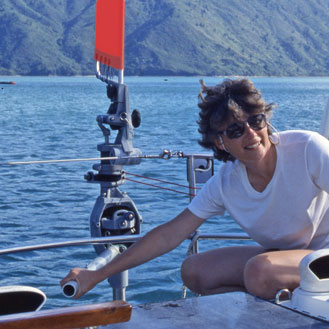
Doubles as Emergency Rudder/Steering!
True Stories

Golden Globe Update Day 113:
[GGR Leader Jean-Luc Van Den Heede sailing the Rustler 36 Matmut] was full of praise for his Hydrovane self-steering. “In a gale it has a big advantage because it is not steering the boat’s rudder, but has its own. This little rudder is far more efficient than the big rudder.”
– Jean Luc Van Den Heede on satellite phone call
“I am happy I did install the Hydrovane, especially that I saw on YouTube that at the same time 2 sailboats almost the same size as mine with the same problem. The crew had to abandon the the ships and left both boats in the middle of the Atlantic and lost everything … again thanks to the Hydrovane. It saved my boat.”
– Jacques Glaser, Amel Mango 52
“My wife and I have just completed a two month cruise with our new Hydrovane and it has performed beyond all expectations… If cruising I wouldn’t go to sea without one: strong, simple, reliable, an emergency helm and an extra crew member who never complains and doesn’t need a watch system.”
– Pete Goss, MBE, Frances 34
“So, I must tell you, and I mean this sincerely, the Hydrovane is simply a game changer for Quetzal. It’s just great and performs better than I expected… One other feature of the vane that I really appreciate is that it eases the load on the rudder and rudder bearings.”
– John Krestchmaer, Kaufman 47
“With just two of us on board, I wanted a system that was simple and effective to operate, and it has exceeded my most optimistic expectations by a considerable margin. It truly is our third crew member.”
– John Mennem, Jeanneau 45.2
“…it is still the most technically elegant solution i have ever seen for a wind vane… I was clawing off a lee shore on one side, and islands on another – winds were reported at 55 knots, and waves in the region were at least ‘boat length’ high and quite steep with the currents. This was an awful night and I was very afraid for myself, the boat and my equipment – I had new found respect, trust and comfort in the Hydrovane after that.”
– Steve De Maio, Contessa 26
In this recent Pacific crossing, the Hydrovane kept us on course (relative to the wind, of course) for several days at a time, requiring no tweaking or attention at all. If you can balance your boat and twist a dial, you can successfully operate a Hydrovane. Don’t leave home without one!
– Bill Ennis, Passport 40
“For the first time, we had to run downwind, under bare poles in gale force 8 conditions, with gusts to 50 knots – and don’t get me started on the sea conditions! Have you ever swallowed your tongue? Oh, and iVane, our wind-steering partner. What a gem! It steered 230 hard miles without even nut rations.”
– Brian Anderson, Hallberg Rassy 40
“The additional cash to purchase a windvane was almost too much… Just how good is this ‘Hydrovane’ anyway?”
After 29,000+ miles: “We’ve said to each many times that without doubt the most valuable piece of equipment on board was Casper – best purchase EVER. I will never own an offshore boat again that does not have this device.”
– Ryan Robertson, T 40
Swim Step / Sugar Scoop
External rudder, watt&sea bracket, other products.
Watt&Sea Hydrogenerator
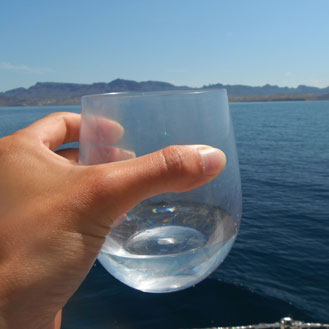
Echo Tec Watermaker
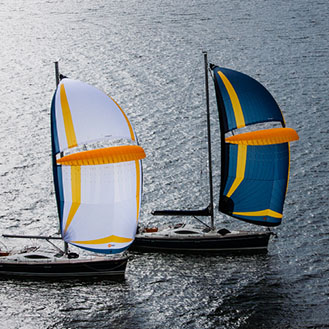

Happy Halloween! This costume may have been for a different occasion but relevant nonetheless! 👻 “After seeing what Taurus [the Hydrovane] does for us [my friend] fell in love with him too. So much so that when the crew dressed up for the equator crossing, she dressed up as a Hydrovane!” - Norlin 37 owner 🙌🙌 ... See More See Less

- Comments: 1
1 Comment Comment on Facebook
How times change just thought I’d send you this video that somebody sent me that bought a Hydrovane ❤️x
Well that was a fun night. 🎉 Thanks @cruisersawards Young Cruisers' Association for bringing together so many inspirational sailors and story tellers! Get out there and chase the wind ⛵️ #cruiserawards #youngcruisers #internationalcruiserawards #seapeople #annapolis #usboatshow #hydrovane ... See More See Less
- Comments: 0
0 Comments Comment on Facebook
#repost from @kirstenggr ⛵️ “Thinking back on the sailing, and missing it! Thanks to @ hydrovane for having serviced Minnehaha's hydrovane , which did about 45 000 nm before having any major overhaul - possibly more than any hydrovane has ever done before without a significant service. It saw Kirsten and Minnehaha all the way through the GGR and over the finish line! The unit is as good as new again, and it was smooth sailing all the way down to Madeira! Also, a big thanks to Eddie Arsenault, for having built such a solid mounting bracket for the hydrovane ! Without Eddie, Minnehaha would just not be the strong boat that she is today!” ... See More See Less
- Comments: 2
2 Comments Comment on Facebook
Wow, absolutely so proud my fathers invention and so glad everybody is so still going strong with this after so many years!! It is so lovely to see !❤️
Any photos of the mount Eddie made?
Thank you Kirsten Neuschäfer ! You are an inspiration. The Hydrovane loves sailing as much as you do 😀 Kudos to Eddie for the rock solid install! Thinking back on the sailing, and missing it! Thanks to Hydrovane International Marine for having serviced Minnehaha's hydrovane, which did about 45 000 nm before having any major overhaul - possibly more than any hydrovane has ever done before without a significant service. It saw Kirsten and Minnehaha all the way through the GGR and over the finish line! The unit is as good as new again, and it was smooth sailing all the way down to Madeira! Also, a big thanks to Eddie Arsenault, for having built such a solid mounting bracket for the hydrovane! Without Eddie, Minnehaha would just not be the strong boat that she is today! ... See More See Less

Hydrovane is my most trusted crewman.
Lee Colledge Shaun Colledge see what you have built 💪 👌
Once upon a time under spinnaker between Niue and Tonga 😍 ... See More See Less

This week we sailed from Lemvig Denmark to Vlieland Netherlands. 270nm and a tough journey for us and without the Hydrovane it really wouldn't have been possible for us. It gives us peace of mind while sailing and can no longer do without it. Boat is a Barbican 33.
Yachting Monthly
- Digital edition

Windvane steering: why it makes sense for coastal cruising
- Will Bruton
- October 15, 2018
No electricity needed, built for gale-force conditions and currently experiencing something of a renaissance amongst cruisers; windvane self-steering makes sense for coastal cruisers as much as offshore voyagers. Will Bruton took an in depth look at the options and how they work.
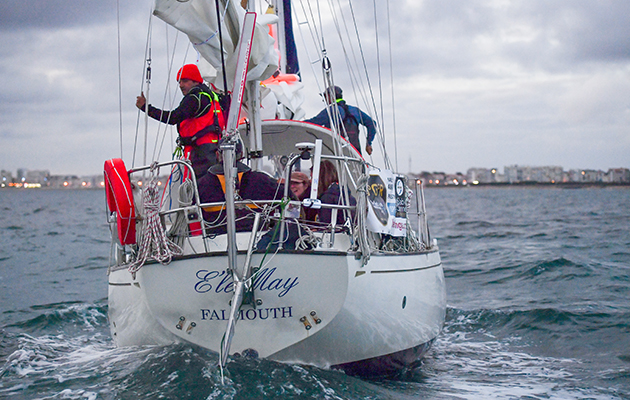
‘The distance run was 2,700 miles as the crow flies. During those 23 days I had not spent more than three hours at the helm. I just lashed the helm and let her go; whether the wind was abeam or dead aft, it was all the same: she always stayed on her course,’ wrote Joshua Slocum in 1895.
The ability of his long-keeled Spray to hold course without input from the helm was instrumental in making her the first yacht to circumnavigate single-handed.
Few modern boats bear these inherently balanced characteristics, so some form of autopilot is necessary to allow the skipper to rest.
Even for crewed passages, it can take an enormous strain off the crew without draining the battery. Some insurance companies even count windvane steering as an additional crew member, such is its contribution to life on board.

Unlike an electronic autopilot, self-steering needs no power
One solution experiencing something of a renaissance, is windvane self-steering.
Requiring no electricity, mechanical self-steering gear was first designed in an age when autopilots were the preserve of large ships and heavy motor cruisers. The principle is relatively simple and pure physics.
What mechanical self-steering cannot do is hold your yacht on a compass course. However, as anyone that’s experienced a sudden wind shift or squall whilst away from the helm knows, steering to a wind angle is preferable most of the time as you are far less likely to crash gybe, and the sails remain correctly set.
Self-steering gear achieves this by presenting a vane directly into the wind. When the wind acts on either side of this vane, it tips, transferring this action through the mechanism below to either a rudder or a servo pendulum which acts on the main rudder, altering the boat’s course.
The two main systems
Servo-pendulum
A derivative of the servo-trim tab principle invented by Blondie Hasler, servo-pendulum self steering gear uses the speed of the yacht going through the water to push against the servo-paddle, creating a substantial force, which is then transferred to the yacht’s own tiller or wheel by control lines.
The wind itself does not provide the power for the steering; rather it adjusts the angle of the paddle, relying on the hydro-mechanical energy of the boat going through the water to do the work of steering the boat.
Popular before the advent of the small craft electronic autopilot, it’s particularly well suited to yachts under 40ft in length, and can be swung out of the water when not in use.
There are now several derivatives, including some available as a self-build kit. Amongst the Golden Globe Race entrants, models included Aries, Monitor, Windpilot and Beaufort systems.
One disadvantage of the servo-pendulum gear is that it uses the yacht’s rudder, meaning it does not double up as an emergency rudder should the yacht’s steering be disabled, although some servo-pendulums can be adapted.
Direct drive systems
Wind vane steering linked to a secondary rudder is the most inherently simple of the mechanical self-steering systems, but relies on a much more powerful transmission of force between a large-surface-area wind vane and the system’s own independent rudder.

Direct drive systems feature a large fully independent auxiliary rudder
This has the advantage of ensuring a back up steering method is already on board but also requires a heavy-duty installation to bear the load and strain that will be exerted.
One of the most popular models is the Hydrovane, which is now available in several different sizes and shapes depending on the boat it is being installed on.
The size and shape of the fabric-covered windvane is directly proportional to the size of yacht, and has been installed successfully on yachts in excess of 50ft in length, including multihulls.
When the boat veers off course, the wind hits the vane on one side or the other, deflecting it away from the vertical.
This then acts on a gear that converts this sideways movement into rotation to directly steer a relatively large rudder suspended from the boat’s transom via the installation framework.
Setting up windvane steering
Balancing the boat.
‘Before doing anything, you have to get the boat sailing well. It demands you take the time to get your boat properly balanced, correctly reefed and with no weather helms; so it actually makes you a better sailor!’ explains Nick Nottingham, who recently fitted a Hydrovane to his Hallberg-Rassy 42, Spellbinder . Nick is about to use the system on an Atlantic circuit.

Self-steering relies on a well balanced boat. As the wind shifts, the mechanism corrects
Self-steering gear works by adjusting the yacht’s course in relation to the apparent wind. The first step to making this work as efficiently as possible is to balance the boat and reduce the amount of input required.
Sailing conventionally, the yacht should be easy on the helm and not overpowered.
Setting the system for the conditions
Whether servo-pendulum or direct drive, most self-steering systems have one or more methods of adjustment for the conditions. In light airs, the wind vane will be exposed as much as possible to the wind, to exert the maximum force on the system, whereas in heavier weather, the vane’s height can be lowered, reducing the force acting on the system.
Some systems, like the Hydrovane, Monitor and Beaufort have different sized vanes that can be swapped, while the Windpilot and Aries allow the vane to be raked aft, presenting a shorter level.

With the wind vane attached, you are ready to remove the locking pin and engage the steering mechanism
On some set ups, the power exerted on the steering system can also be adjusted at the point where the wind vane meets its pivot, just like changing sensitivity on an electronic autopilot. By controlling the rotation of the rudder or paddle created by the windvane, you control how aggressively the system corrects the boat’s course.
Changing the gearing at the point where the wind input creates the steering output achieve an increase or decrease of ratio.
Engaging the system
To engage the system, set the yacht on course and adjust the wind vane so that the wind is flowing over it with the least resistance, like a blade.
If you a using a system with its own rudder, centralise and lock the yacht’s main rudder, simultaneously engaging the self-steering mechanism.

Once engaged, monitor how the system adjusts and double check your sails are trimmed correctly.
As the vane moves it will adjust the steering accordingly.
In heavy weather, reduce the system’s power to ensure the least amount of strain.
Self-steering systems work efficiently in strong winds but most will steer comfortably in light airs as well.
Course adjustments
When the wind vane is vertical, you are on course. When the vane is deflected, the system is adjusting course.
Changing the direction you want to go in is simply a matter of altering the self-steering system’s vane angle relative to the wind.

On most systems this is achieved by a steering line that can be run into the safety of the cockpit, meaning you do not necessarily need to adjust the vane itself directly.
Make small adjustments until the yacht comes onto the desired course, trimming the sails appropriately.
A standalone system?
Whilst self-steering systems offer a much more resilient option than an electronic autopilot for heavy weather, when there is no sailing wind, they cease to be useful.

Here an electronic tillerpilot has been plugged directly into the Hydrovane auxiliary rudder
For this reason, most cruisers also have a conventional electronic autopilot on board to steer under engine.
In the case of systems incorporating a rudder, many also make it possible to easily engage a tiller pilot onto the system’s auxiliary rudder for use under engine.
Self-steering on the Golden Globe Race
If there’s one place that mechanical self-steering fandom bordered on the evangelical this year, it was at the start of the Golden Globe Race .
50 years previously, Robin Knox-Johnston’s world first single-handed circumnavigation was steered by his own self-steering gear system until it failed near Australia.
Restored to her former glory, Knox-Johnston’s Suhaili joined the parade; along with Indian competitor Abhilash Tommy’s replica yacht Thuriya , which sports a commercially made Windpilot servo-pendulum system.

Self-steering gear on Suhaili. Credit: Nic Compton/Alamy Stock Photo
With this year’s revival competition using 1960’s technology and electronic wizardry strictly prohibited, mechanical self-steering systems are effectively the only option for competitors. Each has chosen carefully.
Competitors in the race are using a variety of systems including Hydrovane, Aries, Monitor, Windpilot and Beaufort.
Due to the nature of the boats competing being long keeled, they are ideally suited to mechanical self-steering, naturally holding course better than a modern hull. However, should systems fail and prove unrepairable, it will be hard for them to remain competitive in the race.
Enjoyed reading this?
A subscription to Yachting Monthly magazine costs around 40% less than the cover price .
Print and digital editions are available through Magazines Direct – where you can also find the latest deals .
YM is packed with information to help you get the most from your time on the water.
- Take your seamanship to the next level with tips, advice and skills from our experts
- Impartial in-depth reviews of the latest yachts and equipment
- Cruising guides to help you reach those dream destinations
Follow us on Facebook , Twitter and Instagram.

Hydrovane ® – Your best crew member
Hydrovane® at a glance, the hydrovane self-steering windvane is both a mechanical self-steering windvane for offshore sailboats and an emergency rudder..
With our Hydrovane ® wind-control systems, we offer a combination of wind-vane control and an always-ready emergency rudder, suitable for every stern.
Off-centre assembly, even for modern yachts with bathing platforms, tailgates and catamarans, can be subsequently equipped. These systems are the first choice for many blue-water sailors today. tom logisch is also specialised in installations on large catamarans.
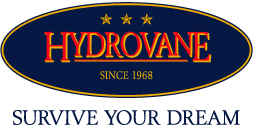
key benefits
Advantages of using hydrovane self-steering windvane solutions.
- Suitable for all blue-water yachts – for all yacht sterns and catamarans
- Off-centre installation possible – for all modern yachts with bathing platforms
- Emergency rudder ready for use at any time – a considerable safety benefit
- Simple operation – ready for use in four simple steps
- Independent rudder – no connection to the main rudder
- No lines across the cockpit – therefore also suitable for hydraulic controls/centre cockpits
- Adjustable wind vane for heavy yachts
- Worldwide services + ARC services
- Assembly and installation by tom logisch
Please see our tom logisch installation service +
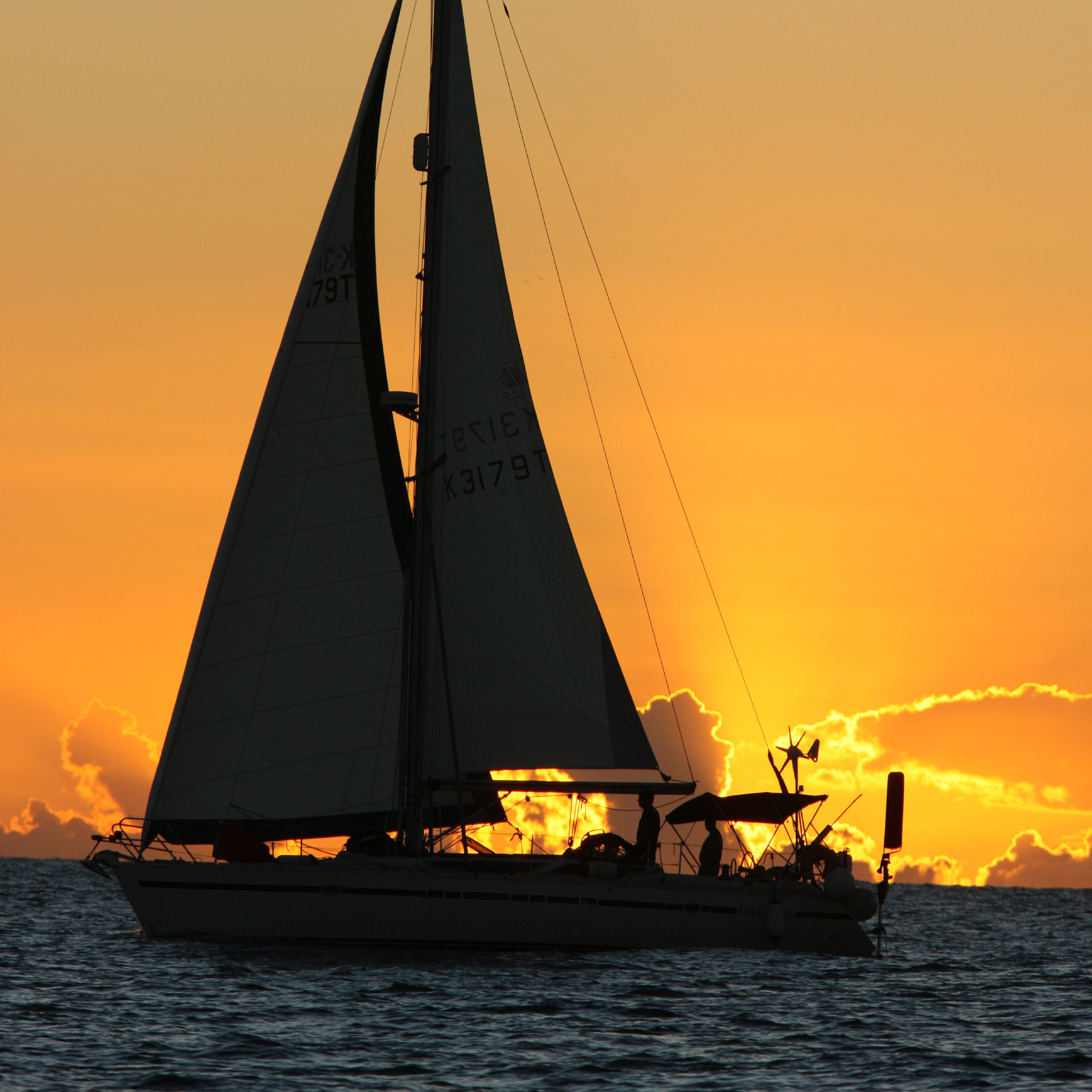
Hydrovane – Your best crew member
Last updated: 21 Aug 2023
- Hydrovane ® YW press article, August 2012 + (PDF)
- Hydrovane ® sailing downwind review + (PDF)
- Hydrovane ® new owner manual + (PDF)
- Hydrovane ® installation guide, March 2023 + (PDF)
- Hydrovane ® measurement worksheet + (PDF)
- Hydrovane® warnings for installation + (PDF)
- Hydrovane ® Montageanleitung V18042016 + (PDF)
- Hydrovane ® Beschreibung V18042016 + (PDF)
Privacy Overview

Email us: [email protected] | Phone: (510) 215 - 2010
Windvane Steering
Windvane self-steering options fall into two categories, servo pendulum and auxiliary rudder. Servo pendulum solutions utilize your boat’s own rudder and as the name suggests, auxiliary rudder products work with a separate, independent rudder system.
We believe servo-pendulum systems like the Monitor are usually your best option. They are more powerful, and perform better across a wider range of conditions on most boats
You'll find a comprehensive review of the comparative merits of both systems at " Auxiliary Rudder vs. Servo-Pendulum " in our library.
At Scanmar, we manufacture the Monitor Windvane servo pendulum system, and the Saye’s Rig, which is often the best choice for very large boats with high freeboard.
Whatever your unique requirements, we have a self-steering solution for you.
Monitor Windvane
Saye's rig.

Yachting World
- Digital Edition

How (not) to set up a wind vane: An extract from Tom Fisher’s Arctic Smoke blog
- Tom Cunliffe
- November 17, 2020
It can take a bit of effort to strike up a working relationship with a self-steering wind vane but, as this skipper found, it can be well worth it

The ‘Hebridean’ wind vane at work on Arctic Smoke. Photo: John Fleming
Like me, you may have followed with interest the stories about failed self-steering wind vanes that emerged from the last Golden Globe Race . My own experience of a Windpilot Pacific on my 20-ton gaff cutter Westernman showed that, set up with sympathy for the boat and the conditions, this equipment is hard to fault.
Decades ago, I sailed the North and South Atlantic with a Gunning pendulum-servo gear on another gaff cutter. The Gunning looked agricultural, yet it performed without demur for years. I almost never hand-steered either boat under sail.
This Great Seamanship extract is from a hitherto unpublished article by Tom Fisher about Angus, his ‘Hebridean’ wind vane on Arctic Smoke , a 1974 Elizabethan 33. The subtitle to his original copy read: ‘A tale of repeated user errors with a happy ending’. That, I think, says it all.
The Hebridean is a light, inexpensive gear, produced in kit form in Scotland. Tom shows how an intelligent, experienced sailor capable of basic DIY maintenance can work his way through the teething issues and end up with a noble system that changes his life. Vane gears are not ‘plug and play’. They need understanding, like people, which is probably why so many of them end up with names. Mine were called Percy and Wolfgang.
Read on, meet Angus, and find enlightenment.
From Tom Fisher’s Arctic Smoke blog
Arctic Smoke left the UK in April 2015 bound for the Azores via Lisbon. She subsequently completed a full Atlantic circuit. The previous year I had bought and fitted an Aries wind vane system. It worked fine but was heavy enough to bring the stern down a couple of extra inches.
I was also concerned about whether the stern would prove strong enough to support the weight through the challenging conditions we expected to encounter. Therefore, at the end of 2014 on the recommendation of a friend, I bought a Hebridean kit.
Angus was finished only a couple of weeks before we set off, the ‘we’ being me and my pal Tony. I foolishly didn’t undertake any sea trials before leaving and that was to prove a significant omission. Casting the lead-shot weight that counter-balances the vane was one of the last jobs. We got the epoxy mixture wrong and the whole thing fell apart and scattered all over the saloon floor.
Article continues below…

The Dark Transat: how to sail across an ocean after total power failure
A complete power failure mid-ocean is thankfully rare, and it is usually the charging system that fails rather than batteries,…

How new-age sailing autopilot systems are putting computers at the helm
A couple of decades ago I’d have recommended anyone planning an ocean crossing without a big crew to fit wind…
Time was pressing, so we swept the mess up and tried again. This time it all stuck together but we didn’t realise that we had lost a significant amount of lead shot into the bilges. The weight was therefore rather lighter than it should have been. This was to cause us a great deal of grief.
A week or so later in March 2015 we left Chatham on a brisk day with three crew. For reasons that escape me other than bone idleness on my part, Angus didn’t get a look-in on the legs down to Plymouth. Perhaps I was secretly worried about whether he would work properly, but whatever the reason we simply relied on the tiller pilot when we got bored with hand steering.
It was only after our departure from Plymouth that we attempted to press Angus into service. He didn’t work at all, even after we figured out that the counter weight should be pointing into the wind and not away from it. The weather was fresh – we were beating into a lively south-west wind to escape the western approaches and it was bloody cold.
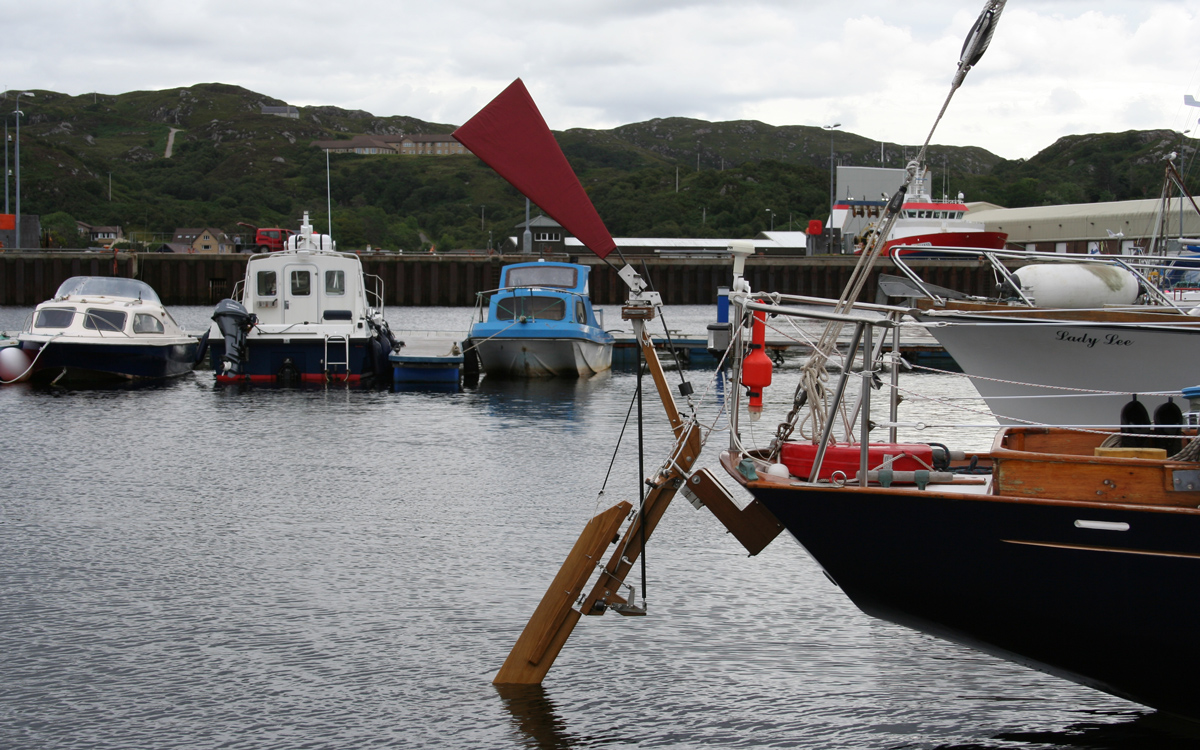
Conditions were not ideal for setting up a wind vane and so, after a few hours of fiddling about and reading the instructions, we reverted to the tiller pilot. It lasted for 24 hours before it burned out, so we ended up hand-steering all the way to La Coruña.
In Coruña we went through the instructions yet again, adjusted the angles of the tiller lines and moved the connecting point on the tiller further back to get more power. We then day-hopped round to Vigo with no noticeable improvements in performance, and Sharon (my wife) flew out with a new tiller pilot.
We fiddled around with Angus some more in Vigo, including adjusting the length of the counterweight rod and to our great relief Angus was at last able to steer the boat – sort of. But he could not be left on his own for very long. By the time we got to Lisbon, we had made numerous further adjustments to just about every one of Angus’ moving parts, as well as his various pulleys and lines, and were confident enough to carry on with the trip.

We were not, however, 100% satisfied. There was one more thing we needed to check – the counterbalance. I had previously emailed the designer John Fleming to ask his advice and, having relayed the latest symptoms to him, he recommended we check the counterbalance weight. This required accurate electronic scales – but we could not find a set anywhere.
Then, quite by chance, we bumped into a young couple who not only had a set of scales on board but also some lead sheet! The weight was light by a few ounces. The solution was to cut a strip of lead sheet of the required weight and wrap it around the counterbalance weight.
As a temporary measure, we tapped the weight and screwed the lead strip onto it. Like many of my temporary fixes, that one is still in place. Finally, therefore, we were hopeful that the combination of trial and error, John’s excellent after-sales service and the final ingredients of the scales and the lead sheet had resolved all the issues. However, we would have to wait for some more challenging conditions to be sure.
More tweaks required
Our next leg was to Madeira on a close reach in fresh winds and some pretty big seas. During this passage one further problem presented itself. Angus’s servo paddle can swivel upwards if it hits an obstruction, preventing major damage. The force of the large waves now beat the system, repeatedly swivelling the paddle clear of the water so that he lost control. Friction bolts are fitted to prevent this, but even after tightening these to the maximum the problem remained.
The instructions suggest using a shear pin, strong enough to prevent this but weak enough to break if necessary. However, with Arctic Smoke ’s keel-hung rudder protecting Angus, the paddle is pretty safe, so I inserted a stainless steel bolt through the mounting beams just behind the pivot assembly to prevent Angus from rising up. Angus now performed entirely to our satisfaction and we had no cause to reprimand him for the rest of the 2015 cruise. Indeed, he became quite taken for granted.
Arctic Smoke arrived in the Canaries in August 2015 and remained in Pasito Blanco for the next 12 months. I returned in September 2016 to prepare her for the Atlantic crossing . My friend Mick joined me and, before our November departure, he gave Angus a thorough service including tightening various nuts and bolts that had worked loose.
The first big test came on our crossing to Martinique. We soon picked up fresh tradewinds and ran under twin headsails – the genoa boomed out with the main boom and a jib hanked on to the emergency forestay poled out with the spinnaker pole.
Within a few days the wind was blowing Force 6-7 and we were running under a deeply furled genoa and a small jib. The seas were far and away the biggest I had experienced and were usually coming from both quarters as well as from astern. With her classic long and narrow underwater profile, Arctic Smoke rolled horribly as her stern was lifted and shoved to one side and then the other.
This also pushed her off course but providing the wind strength was reasonably constant Angus recovered her heading unaided. This was the case for most of the first two thirds of the crossing.

A properly set up wind vane can make light work of most sailing conditions
In the later stages, however, we were pummelled by frequent squalls and sometimes, despite Angus’s best efforts, Arctic Smoke was slewed round so far that one or other of the headsails would back. With enough time, this was self-correcting as the backed sail pushed the boat’s head back on track. However, the forces on the rig were enormous and the whole boat would shake as the backed sail first went slack and then filled with a mighty snap. In these conditions, it was necessary to help
Angus counter the effect of the stern being pushed round by applying some extra force on the tiller, but for the vast majority of the time he coped unaided. It may be that moving the tiller attachment a little further back towards the rudder shaft will improve Angus’s response time still further, but that’s an experiment yet to be undertaken.
During that last week of the Atlantic crossing (we travelled the 2,200 miles in 16 days with an average speed of just under 5.5 knots) Arctic Smoke dealt with the biggest and most confused seas of the entire circuit, together with frequent squalls of near gale force.
However, it was not until the passage from Bermuda to the Azores in May 2017 that we experienced our first full and sustained gale. Between times, I sailed on my own from Jamaica around the south and north-west coasts of Cuba, through the Florida Straits and the Bahamas to Bermuda.
I encountered the full range of weather conditions short of a gale. I rarely if ever had to help Angus. Indeed, even in the most unfavourable conditions – very light airs from astern – Angus was able to steer a course.
It was only now I fully comprehended how the various forces interacted, and how they affected Angus, so I could work out the best approach to setting him up. After hours of observation and numerous mistakes, this is therefore my take on setting up a pendulum-servo wind vane:
Acquiring the knack
Compensating for weather helm is key and is best done before making final course adjustments. More sail equals more weather helm and there’s a limit to how much any type of wind vane system can cope with. So, it’s essential to manage weather helm by setting the optimum sail plan for the wind strength.
Once the vane is clearly responding to changes in the apparent wind direction by moving from side to side and the whole assembly is at right angles to the boat, you’ve got it. Then you make final changes to the angle of the vane to achieve the desired course.
As the passage continues, changes in wind strength will of course alter the amount of weather helm. Significant gusts and lulls produce greater and lesser degrees of weather helm and can be compensated for by moving the chain links that connect wind vane to tiller.
When you run out of adjustment it’s time to reduce sail. With some systems, including Angus, there’s also the question of which vane to use. His largest and lightest is needed in light airs to generate sufficient power. In stronger winds, this one bends and is replaced by a smaller plywood vane about two thirds of the size. I have never used my ‘storm vane’ which is about half the size again.
On the passage between Bermuda and the Bahamas I opted for the standard rig of main and boomed-out genoa in preference to a twin headsail rig. This therefore, is how we were set up when the gale arrived. I’d chosen this sail plan partly because it’s more flexible and partly in an attempt to minimise rolling, which I think it did. The main disadvantage was increased weather helm and so Angus had to work harder.

Read Tom’s entertaining blog at: arcticsmoke.blogspot.com
Fortunately, whilst fitting out in Pasito Blanco, I had a fourth reef inserted into the mainsail. When I first tested it, I was worried that I had overdone it, but when the gale arrived I realised it was just what was required. With the wind from astern or off the quarter, a scrap of genoa boomed out to windward and the four reefs in the mainsail, we left Angus at the helm, put the washboards in and went below.
Very occasionally in the strongest gusts and biggest waves, the mainsail would back (a full gybe was avoided by use of a preventer on the main boom and the sail area was small enough to avoid over-pressing the boat). When that happened I had to get out into the cockpit and steer the boat back round. Occasionally I had to complete the gybe by easing the preventer and re-setting it on the other side.
To sum up: once he was set up properly, Angus was wonderful and I’ll never again go sailing on Arctic Smoke without him!
First published in the November 2018 issue of Yachting World. For more Hebridean information see: windvaneselfsteering.co.uk
Multihulls Catamarans
Catamarans have a relatively long length along the waterline and no ballast at all, and consequently hold a straight line very well. The pressure on the rudder is relatively low as well, so they are easily steered.
They accelerate far faster than monohulls in the puffs, however, which causes dramatic fluctuations in the apparent wind angle. The same is true in the lulls: they slow down quickly and the wind swings aft. The principle is as follows: when a gust hits a monohull, it causes increased heel and minor acceleration and the apparent wind swings forward only a little. A multihull is unaffected by heel but accelerates quickly; the apparent wind angle swings forward markedly.
This explains why catamaran sailors have always relied almost exclusively on autopilots. However a windvane system can be useful on extended voyages.
Servo-pendulum systems can produce perfect steering on catamarans. The great speed potential allows the pendulum rudder to generate substantial steering force. The wind vane functions well as the steering impulse generator as long as the wind strength and angle remain constant. It is no good in gusty weather or if the wind strength is variable because the windvane system will snake all over the place. In these conditions the wind vane can be removed and a small autopilot (cockpit autopilot) used to furnish the steering impulses.

A servo-pendulum system can obviously only function if steering force transmission to the main rudder is smooth. The steering lines should not under any circumstances be lead via the wheel adaptor to a wheel steering system as the wheel is normally some way from the stern on a catamaran. Transmission to the emergency tiller works only if the wheel-steering mechanism can be disconnected; this of course assumes that the helmsperson can easily reach (and steer with) the emergency tiller whenever necessary.
A better approach involves parting the mechanical connection between the two rudders, leaving rudder no.1 connected to the wheel for manual steering and for fine trimming the course when the windvane system has the helm, and connecting rudder no.2 to the servo-pendulum gear via the emergency tiller and the steering lines. Hydraulic steering systems can also be adapted by this method.
Auxiliary rudder and double rudder systems are not suitable for installation on catamarans. The aft beam crosses high above the surface so mounting the gear sufficiently close to the water proves difficult. Even if mounting on the aft beam was possible, it would still leave the auxiliary rudder completely exposed to flotsam.
Continue reading here: Rig sloop cutter yawl or ketch
Was this article helpful?
Recommended Programs

Myboatplans 518 Boat Plans

Boat Alert Hull ID History Search

3D Boat Design Software Package
Related Posts
- Deep fin keel and balanced rudder
- Building a new boat - Wind Steering Systems
- Salomatsystem types and - Wind Steering Systems
- The first windvane steering system
- Servopendulum systems - Wind Steering Systems
- The Windvane - Wind Steering Systems
Hebridean self-steering wind vane
“well worth investigating”
TOM CUNLIFFE The Complete Ocean Skipper
“I’m impressed… the vane performed well on all points of sail, including downwind… the servo pendulum system took control to the extent that it could sail a course with the sails badly set” DAVID PUGH Editor, Practical Boat Owner
Build your own servo-pendulum wind vane from a kit
The Hebridean wind vane is an innovative version of the tried and tested servo-pendulum self steering system for sailing boats steered by tiller or wheel. The Hebridean has crossed Atlantic and Pacific oceans but is also quick and easy to mount for weekend coastal sailing or jaunts across the Channel, Minch or other strait/sea.
Stern freeboard The kit fits yachts with stern freeboards from 600-1000mm (stationary). It is designed specifically for DIY construction. The Hebridean can be tilted up out of the water or lifted off the stern and stored on the guard wires. Or partially dismantled for storage below.
Horizontal vane axle The Hebridean is the only serv0-pendulum vane with an actual horizontal vane axle. One of its unique design features allowing boosted performance, simplified construction and enhanced efficiency in all conditions. John Fleming’s analytical genius was responsible for the innovative geometry on which this landmark development in servo-pendulum windvane design depends.
Simplicity For confidence at sea or in remote locations, the simplicity of its components and assembly crucially allows the unit to be maintained with tools usually found onboard. Building the Hebridean yourself is a hands-on “course” providing you not only with a good understanding of its workings, but also substantial confidence in your ability to maintain it anywhere.
Wood When sourcing your own wood you need 4m of suitable hardwood at 145 x 20mm (EU standard). The longest plank is 1800mm to make the pendulum/paddle for 1000mm height transoms. Here is the wood cutting plan .
Affordable The Hebridean offers DIY sailors the opportunity to build an affordable wind vane in wood and stainless steel, with no welding, bearings or plastic cogs in the main H2 Kit. (there is one worm and wheel in the optional Remote Course Adjustment Kit which can be viewed in action in this youtube video ). All the metal components are prefabricated (drilling and some surface finishing required) ready for you to bolt to the wooden frame. The build requires basic wood-work skills and tools. And several days of absorbing and highly rewarding work.
Wheel steering too A “drum” kit for connecting the Hebridean to wheel steering is available.
Shipping For shipping costs, please contact me at the email address below with your full name, delivery address and phone number (required by carrier) for a quotation.
Kit prices Prices are listed on our Prices & Ordering page.
A section by section video from Hebridean builder, Ian French Thank you Ian!
- Part 1 Intro and frame: Intro & Frame
- Part 2 Turret and Vane : Turret & Vane
- Part 3 Fixtures and fittings : Fixtures & Fittings
- Part 4 Servo Rudder: Servo Rudder
- Part 5 Boat mounting: Boat Mounting
- Part 6 Testing the wind vane: Testing the Wind Vane
- Part 7 Wind vane in action
- Part 8 See the remote steering mechanism being assembled . The single weld required in Part 8 is completed by us before kit dispatch.
- Part 9 Preparing Remote Control Lines
See the Hebridean in action
- Videos shot in Scotland in varying sea and wind conditions Scotland Sea Trials
- Trials over 8 years of coastal and off-shore sailing by John Fleming, the designer of the Hebridean Wind Vane The Hebridean in action.
- Emmanuel sailing on Lake Geneva with Mont Blanc in the background Wind Vane in action on Lake Geneva
- Mounted on the 45 degree rudder stock of a Twister off the Scilly Isles https://www.youtube.com/watch?v=FNlZHFFseB0
- Finnish archipelago Sailing https://photos.app.goo.gl/hYWTEcJhbdX3WGe39
- Wheel steering , all beautifully finished, on Al Hanson’s Pearson 31-2. Al’s video also features his removable Hebridean mounting solution attached to his folding transom boarding ladder.
- 1912 Falmouth Quay Punt Plymouth https://www.youtube.com/watch?v=n6BIxYQUPiM
- Wind vane and dolphins off Fair Isle https://vimeo.com/136486631
- Courtesy Tom Fisher on “Angus” The Hebridean Wind Vane in action in strong winds 25/5/17 Bermuda to Azores https://www.youtube.com/watch?v=Po-oXzVaIAk
- Kristian Møller Pedersen’s first day out with the Hebridean on trial after having completing the wind vane also see testimonials page https://youtu.be/d2fjzbkh0dU
- https://www.youtube.com/watch?v=Yg7JgwH6Y58
- https://youtu.be/1090Z-dK2Ys
- https://www.youtube.com/watch?v=EjAUfm-i6Yw
- Hebridean mounted on top of rudder stock on a canoe stern sailing off Canary Islands Hebridean in use in Canary Islands
- An afternoon sail in 10 to 15 knots on Port Phillip Bay watch-v=QBx0ywAjMCA&feature=youtu.be
- Video of the “drum” kit watch-v=4KLWJbYYOF0&feature=youtu.be
Frequently Asked Questions

John Fleming 1951 – 2023 teacher yachtsman inventor thinker
“We’re going…that way!”
Here is a 10 minute video tribute to the Hebridean’s designer, John Fleming. It was aired at his life celebration in The Tip i at his family home, The Dell, Nethy Bridge, 19 April 2023. https://www.sgmarkphotography.com/Client-Area/John-Fleming Use password sleepyeagle (the name of John’s Pioneer 10).
Notice from Ian Kirkwood
When John’s health got worse, he asked me again to take on the project. I am an enthusiastic fan of his highly ingenious version of the servo-pendulum self steering-system. I sailed in company with John on and off for a decade — using my own Hebridean (I was his first customer in 2013).
Our Hebrideans steered us around Scotland’s northwest coast and isles. We made three trips in company to the Faroe Islands. On the first of these I sailed happily solo. All thanks to the Hebridean. Dying winds foiled an attempt to reach Iceland: our boats lay calmly hove-to overnight a few miles off the Butt of Lewis. Plan B proved to be a fabulous voyage down the length of the Atlantic coast of the Outer Hebrides. A highlight was anchoring off Callanish in blazing sun.
I hope to continue John’s personal style of service. Please allow a generous lead time as I get used to stocking the components and preparing Hebridean kits while maintaining their high quality…and a reasonable kit price in times of rising costs.
Attainable Adventure Cruising
The Offshore Voyaging Reference Site
- 11 Self-Steering Vane Gear Installation and Usage Tips
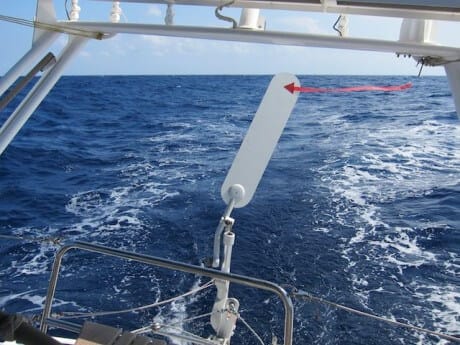
The first time I used a vane self-steering gear in anger was back in the early 1980s, aboard my newly purchased UFO 34 cruiser-racer whilst delivering her home from Scotland through the Irish Sea.
Fitted with a then state-of-the-art Aries vane, we had strong tailwinds for much of the way, which the vane handled fairly well, impressive because the UFO was an early IOR design and a known handful downwind.
But when the wind eased, the vane really began to struggle, failing to respond quickly enough to hold a course, and in the end we had to take over by hand.
Over the next few weeks we tried everything to sort this out, with the aid of the late Nick Franklin, designer and builder of the Aries.
We cleaned all of the bearings, added a lump of plasticine to the counterweight, and even tried attaching elastic cord to help the vane recover, all to no avail.
Finally, during a last despairing chat with Nick the main culprit emerged. “You haven’t by any chance painted the blade?” queried Nick, and immediately the penny dropped—the previous owners had painted the plywood blade with several coats of gloss, and added an attractive logo on both sides at the top—and this was enough to unbalance the blade to the extent that it wouldn’t recover to vertical quickly and smoothly.
So here are 11 more things we have learned about our vane gear over the years:
Login to continue reading (scroll down)
Please Share a Link:

More Articles From Self-Steering:
- Windvane Or Autopilot?
- Q&A: Windvane Or Autopilot?
- The True Price of Autopilots & Vane Gears
- Autopilot Buyer’s Guide
- How To Tune an Autopilot to Steer Better—Part 1
- How To Tune An Autopilot To Steer Better—Part 2
- Nine Autopilot Usage Tips and Hacks
- Gear Test—Autopilot
- Q&A: Which Autopilot Drive?
- Autopilot Installation Problems and Lessons Learned
Hi Colin, It was an essential article in 2011 and remains an essential article for wind vane users a decade later. I used a Monitor, but my comments apply to any windvane user. It has been my observation that too many cruisers neglect (and perhaps do not think of or appreciate) the fine tuning that can be had with their traveler and just leave it amidships most of the time. This capacity for fine tuning can be especially important when trying to get a windvane to behave. A few inches to leeward or windward powering the main up or down can make a nice and easy adjustment to balance the helm and might save the effort of throwing in a reef only to shake it out 30 minutes later. My best, Dick Stevenson, s/v Alchemy
I agree on the traveler and think it’s often one of the most neglected, and yet useful sail controls on the boat. I think it was Bob Perry who said you can always figure out who is a cruiser by the cobwebs on the traveler.
Colin, Dick, John – on a Boreal tiny adjustments to the daggerboards are the secret sauce – we once went 3 full days in a trade wind crossing (Windpilot) only adjusting the daggerboards (usually the leeward one) up or down a few centimeters. I think this speaks to the truism that wind vane gear is most commonly limited by your sail trim expertise with the boat. For us, our Windpilot performance, especially in light air, weird seas, etc… was radically improved overtime on the basis of our ability to properly trim the boat. Seems like most folks name them something magical because when you get’m working it is magic – we called ours “The Wizard”
On our C&C 35, you pretty much have to put the traveller up to windward if you’re close-hauled in light air, and she’ll heel over and fight the helm if you neglect to move it to leeward as the breeze builds or as you turn downwind. (Also, it’s right in the middle of the companionway, so the crew get rather annoyed if you just leave it on centre.)
I haven’t had a chance to use our Hydrovane in a while. It worked OK on our first voyage, but we didn’t really have the feel of the boat’s balance at that point. I’m curious how much better it will perform now that we have some idea how she behaves, and have rigged up a workable main reefing system. The tendency of the boat’s weather helm to overpower the vane if we left too much sail up was my main complaint about it, and that’s really more on the skipper than on the equipment.
Hi All one of the best things about vanes is that they teach you how to trim your boat at all angles and in all conditions – I, for one, found over time that given the chance I would overshot sails. The vane wouldn’t tolerate this and so I learned better and made faster, more comfortable passages as a result. It’s the same with reefing, selecting the best balance of reefed headsail vs or in conjunction with the main, which will depend on your boat and her sail plan. Robust, quiet, no power drain, what’s not to like?
Hi Dick, Colin & John. A Monitor windvane has done 85% of the steering for over 30,000 nautical Bluewater miles and I agree that sail balance is key. On one of my haul outs I very carefully cantered the rudder and marked the top of the wheel with coloured vinyl tape. I then moved the rudder 6 degrees to port and 6 degrees to starboard and marked these two points on the wheel. A quick glance at the wheel indicates the Monitor is struggling. Before touching the Monitor control lines I first try to re-establish balance usually by dropping the traveller. If that is only partially successful it is usually time to put another reef in the main.
Different boats may respond differently to the various sail adjustments and you have to learn how to achieve a neutral balanced helm on your boat. As others have said this is also faster and more comfortable.
Absolutely, in fact your 6 degree marking idea is a great tip whether we have a vane gear or not. For example using the same trick with an autopilot reduces load and electrical use a bunch.
The other trick is to get into the habit of hand steering for 5 minutes every hour or so of a watch. Another good way to check if the trim is wrong, although your way is more definitive.
I would be interested to hear how well the Sailomat performed on Morgan’s Cloud. I found that particular wind vane very difficult to set and unreliable to leave unattended. I have replaced it with a Hydrovane which is wonderfull and a joy to use.
Same experience. We got it working eventually, but had to rebuild the damned thing at vast expense. Not recommended.
A big yes to putting a tell tail or two on the air vane. It is amazing how just a little gear stored in the vicinity of the vane gear can change the apparent wind the vane sees. Until I discovered this, getting the set right, used to drive me mad, until I would just give up in frustration. No longer.
The importance of having a balanced helm cannot be under estimated. Using a traveler is something few cruisers hardly ever adjust. If it too hard to adjust, work on changing that. Increase the purchase on the control lines. Change to a ball bearing car if necessary. Make the track as long as possible. Then learn how to use it. You will be glad you did.
Tell tales on the air vane work wonderfully well and don’t alter the essential balance of the vane. Cost nothing, too…
Great article. 2 years ago I was looking for a new windvane for my Luders 33 and I only had a few choices Hydrovane, Cape Horn, Windpilot and Monitor. Unfortunately all out of my budget (all >6K CAD). Unfortunately several makers went out of busines over the last several years, and in this age of electronics, this is a niche market. But it’s worth mentioning that there is a new kid on the block, and Windy out of Estonia is well built in stainless steel and very fair priced (2K CAD including shipping). I have one installed and I am really happy with it. Another option for anyone looking for a windvane.
Hi Marcelo, thank you for the pointer to Windy ( https://windyselfsteering.com ). Although I am not (yet) looking to buy a wind vane – still more urgent investments to do on my 22 year old boat – I found they also provide mast steps, at an unbeatable price, and Imre is a very responsive guy and seems quite knowledgable. I am now awaiting my 24 mast steps 😉

Both windvane and mast steps surpisingly cheap and strong. The steps do look quite hard edged. One would probably require protective clothing, shoes and gloves to use them. Also I found with steps that halyards have a nasty habit of wrapping themselves around them, especially at night. I ran light lines down them, both sides of the mast to prevent this. Not pretty but quite effective. With the Windy design you might be able to get the manufacturer to drill holes in the outer profiles to neatly run line through.
I agree on the sharp edges on the steps. The other issue with steps is windage, which, I believe, is far more disruptive than many think. And then weight aloft is an issue too.
For these reasons I always liked the ABI aluminium folding mast steps, but it seems they have been discontinued.
All that said, while I can see reasons for mast steps, and had them up to first spreaders on the old mast on our McCurdy and Rhodes, on balance I would not fit them again but instead rely on ascenders for unassisted mast climbing. Matt and I have a couple of articles in the hopper on mast climbing.
Hi John and Matt, I will be interested in your article on mast climbing. It is my take that many a cruiser neglects work and forgoes inspections, for a wide variety of reasons, when it entails going up the mast. My best, Dick
I am with you both on windage and on folding mast steps. Folding ally steps were going to be my next port of call but maybe I should try out an ascender first. Its got to be cheaper and I hate drilling extra holes in the mast. Has anyone here tried using one while underway ?
No, never been up the mast at sea with ascenders and am very happy about that! That said I did some single handing at one time and before that bought a set of ascenders and practiced with them to the point that I was reasonably confident that I could go up with the boat heaved-to. More in future articles.
Hi John, its been a while, but too bad ABI went out of business, they had some very nice stuff. Regarding windage related to the steps, it is not something I noticed on my previous boat, perhaps a bit noisier in the higher wind scales, but its worth the piece of mind. Going up the mast is the single task I cannot do on my boat, and being a singlehander it has caused headeaches before. It more than paid for themselves for the inumerous times I had to climb in a hurry over the years. So I decided to live with it again on this old boat. I had a heated argument with myself (I always win), and I decided that a radar dome with its brackets and cables weight more than my steps, and these are installed on many masts. Its amazing how we find excuses to ourselves to go ahead with these things, eh?
Hi Ernest, I am glad you got them. I also have bought steps almost exactly as Imre’s but locally and before I knew of Windy’s. I will round the edges before installing, and all 24 of them weight 5 kilos, which makes mine a bit heavier at about 200 grams each. My mast is 40 feet, I’ll place 2 5 feet below the top and one evey 18 inches above the genoa winch, so I am not sure if I’ll use all 24 or them, will install with monel rivets. I will see if I can drill holes on the outside to run a fishing line to prevent snags.
Yup, same here – planning to smoothen the edges before mounting, will install them using 4.8 mm Monel pop rivets. Will be a couple of weeks until I get around to it. @John, as this article is about wind vanes, and not on getting aloft, where might I post some update (if anyone would be interested)?
Both Matt and I have articles on mast climbing in the works, so probably best to wait for them. Thanks for thinking of it. Real world updates on gear are one of the best parts of AAC.
Hi Marcelo,
Thanks for the heads up on that. How many miles have you got on the gear? The reason I ask is that the concern with less expensive alternatives is always longevity under load offshore. Of course there are also examples of gear where a less expensive alternative is just as good and only costs less because the manufacture is more efficient or has lower costs.
Anyway, please keep us informed on how it’s going with the gear as time and miles pass.
The Windy gear looks neat and it’s good to see one fitted on a smaller boat on their website. The last small boat vane I used was the Navik gear, no longer available as far as I’m aware (I think spares can still be had). Which worked wonderfully well and was ideal for a boat with a small battery bank.
Hi John, good point on the cost/quality. The fact that they use most stock items rather than fabrication was one major decision point, it facilitate repairs if needed. I am still tweaking the vane since I only had it for one season, like trying to determine the best route for the lines, etc. I am satisfied with its simplicity, construction and strength and I am confident it will provide long service. The windvance on my pevious boat (Ratcliffe, from Boston, long gone) was also made with stock pieces and I used for over 30K miles without a hicth, pretty much the same scantlings as the Windy. I did call for references and users were satsified with its offshore performance, also, Imre is a circumnavigator he understands the needs. But time will tell.

Thanks for the fill on that, does indeed sound good.
I installed a Windpilot Pacific on my heavy Koopmans centerboard vessel in 2014. It has not got a lot of use, but saved me when required. (electric generation failure mid ocean – so no normal autopilot). From time to time I have been in contact with Peter Förthmann, either to get advice, or buy a small part.
His customer service is absolutely outstanding beyond anything I have experience in this industry and beyond. As regards gear on boats, it is not a question if it breaks, it is a question of when. Then it is good to know Peter F is there to help.
No sponsorship – just a happy customer.

Installing and using wind vane steering
Simple in theory, this classic steering system makes a perfect companion to an autopilot Few things are more enjoyable than steering a boat on a beautiful day. Until you've been doing it for hours upon hours and you've got many miles left to go. That's when a self-steering system makes that passage even better. And whether you want to admit it or not, a self-steering system will likely steer straighter than a human for long periods, shaving miles and time off your passages. The modern answer to self-steering is the autopilot. Autopilots are great but they are not without their weaknesses. Autopilots, along with refrigeration, are the largest consumer of electricity aboard, and traditionally autopilots have not been 100% reliable. Self-reliant practices state that a cruiser should carry a second autopilot in case of a problem, and some people even go to the work of installing a second redundant system so they can hot-swap to a working system should one fail. A traditional self-steering method is the transom-mounted wind vane. These systems consist of a wind sensitive vane and a steering device. As the vane senses changes in the wind it activates the steering system to return the boat to the selected point of sail. The steering system is very typically the rudder of the boat itself. If you have seen wind vanes in boat shows or in your marina, you have probably seen what looks like a little rudder. This rudder is not used to steer the boat but to generate power via water resistance to turn the wheel of the boat. The wind vane senses the wind and the movement of the vane turns the little rudder in the water, little rudder wants to straighten back out due to the water pressure on it and this straightening force, via some rope and pulleys, is transmitted to the wheel or rudder on the boat, and the boat is steered back on course. The system works well if properly engineered and installed, all without power, electronics or noise. Unlike autopilots, which do best in light-to-moderate conditions, wind vanes steer very well in heavy conditions and do not work well at all in very light winds, making the systems great complements of each other. Autopilots and wind vanes steer differently. A wind vane will steer to a constant point of sail, a relative angle to the wind. The autopilot, by default, steers to a compass course or to a GPS waypoint. In a passagemaking situation steering to a course or waypoint is important, but in heavy conditions steering to the wind has its benefits. A a hybrid solution of a quality autopilot and wind vane system may be the best option for serious passagemaking. The autopilot will work great when motoring or for short passages and the wind vane will be the workhorse on longer passages. Installing a wind vane does take a bit of planning. They work best when centered on the transom and set at the manufacturer's recommended height. The second consideration is running the steering lines to the wheel. There are two roughly quarter-inch lines that need to run cleanly from the vane to the steering wheel of the boat. You want these runs to be as short and smooth as possible. You can add blocks to deflect and turn the lines, but every turn adds friction. Remember that these lines are only deployed when the vane is in use. The actual installation should be fairly straightforward as most vanes on the market are adaptable to a variety of hull configurations, and some will even come customized to bolt right on. Standard mounting protocols apply. Through-bolt everything with proper bedding, and use backing plates or at least large fender washers on the inside. Using a wind vane is a little more complicated than just pushing "Auto" on your autopilot, but not much more. The first step is to deploy the gear. The wind paddle is typically removed for storage and the rudder folded up, but both can be deployed in just a few minutes. Next, the control lines are connected to the wheel; this is typically done with knots or a bit of hardware. With the vane deployed, set the boat on course and balance it for the desired point of sail, then adjust the vane to match and engage the wheel. At this point you'll need to evaluate how the vane is sailing, making further adjustments by sail trim. Course adjustments are made by turning the wind paddle to match the new course, and trimming to it. If you need to disengage the system to hand steer for short periods of time, simply disengage the steering wheel attachment, but leave all the other gear in place. The key to success in using any self-steering system is to balance the boat. A boat that is poorly trimmed will not sail well with a human, mechanical or electronic helmsman. Wind vanes steer better on some points of sail, a steady beat offers the best performance, the wind provides lots of steering input signal to the vane. With a self-steering system you'll sail faster, straighter, and can spend more time concentrating on the more enjoyable aspects of sailing. A hybrid system of a wind vane backed up by an autopilot will provide a robust self-steering system for most all conditions.
Also in Technique
- Winch servicing
- Repairing delaminated core
- Splicing Dyneema
- DIY custom bug screens
- Anchoring and mooring a catamaran
- Co-owning a boat
- Installing a steering wheel
- Helming skills
- Captain your own charter
- Asymmetric spinnaker skills
Also from Staff
- Tor Johnson
- Learn to Sail Better
- New boat: Aureus XV Absolute
- Remembering Hobie
- Catalina 275 Sport
- New boat: Saphire 27
- BOAT OF THE YEAR
- Newsletters
- Sailboat Reviews
- Boating Safety
- Sailing Totem
- Charter Resources
- Destinations
- Galley Recipes
- Living Aboard
- Sails and Rigging
- Maintenance
- Best Marine Electronics & Technology

Sailing With a Windvane
- By Alvah Simon
- Updated: December 9, 2019
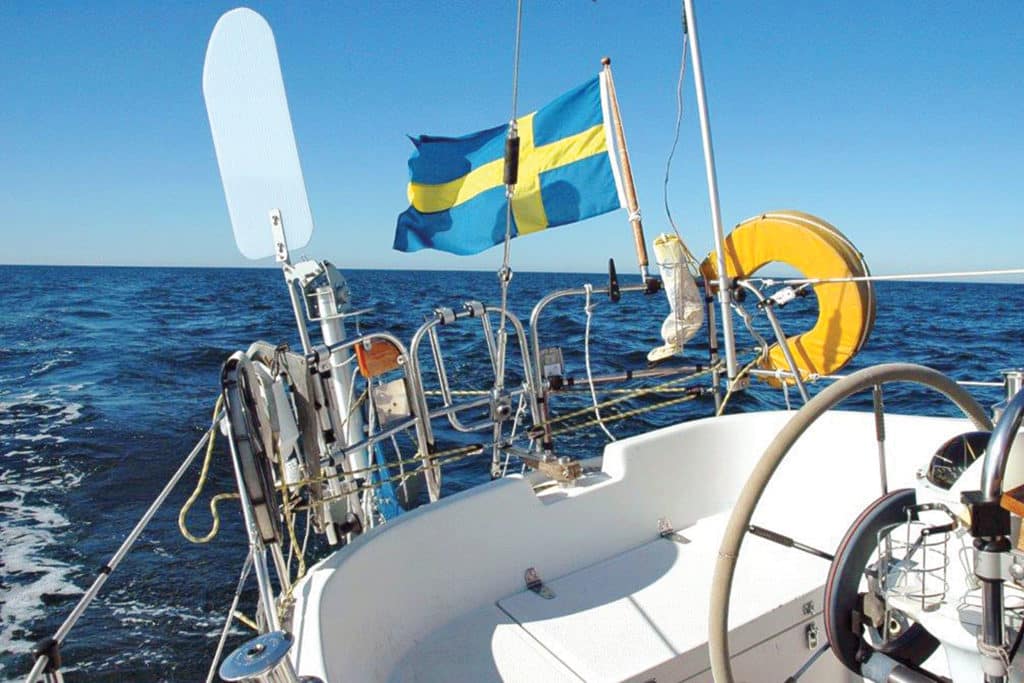
Once found only in the ascetic realm of single-handed sailing, self-steering gear has become ubiquitous on cruising boats, even fully crewed ones. That’s because a self-steering unit serves as an additional hand that possesses relentless concentration at the helm; subsists on only amps or lubricants; and, if properly trained, does what’s asked of it without question or complaint.
Reliable remote control of the helm relieves the fatigue and monotony of following a compass course at night. It allows time for sail changes and adjustments; horizon sweeps for ships; attentive navigation; and that quick dip below to check the bilges and grab a hot drink. Without question, self-steering makes for a more relaxed, enjoyable and safe voyage.
But the debate over which kind of self-steering is best for a sailboat — electric or windvane — rages on. I may be an old-fashioned belt-and-suspenders kind of sailor, but I believe both systems have their different strengths and weaknesses, and therefore complement each other. In other words, any vessel that is configured in a way that can accommodate both methods should do so.
In this scenario, the more robust mechanical sailboat windvane would be employed in heavier weather, while the electric autopilot would be used in light airs and under power, where directional corrections are provided not by the wind, but by a fluxgate compass. It is important to understand that while the electric autopilot maintains a steady compass course, a windvane is set to maintain a desired angle off the apparent wind, and therefore will follow any wind shifts or changes in wind velocity. While this does keep the sails perpetually in trim, the course must be monitored closely when in confined waterways.
That said, if forced to choose, I would go with the mechanical windvane, hands down. Vanes don’t rely on the ship’s electrical power supply, which serves as the last link in a long chain of delicate electrical components and breakable mechanical parts. Across the range of types and brands, mechanical windvanes generate amazing power in rough conditions (when needed most), coupled with notable durability. Almost 30 years ago I purchased an already well-used Aries windvane. It has faithfully followed me from boat to boat, and around the world, with clear indications that it will outlast me. On the other hand, I have an overflowing box of spare parts cannibalized from the many electric tiller-pilots I have chewed through in that same period.
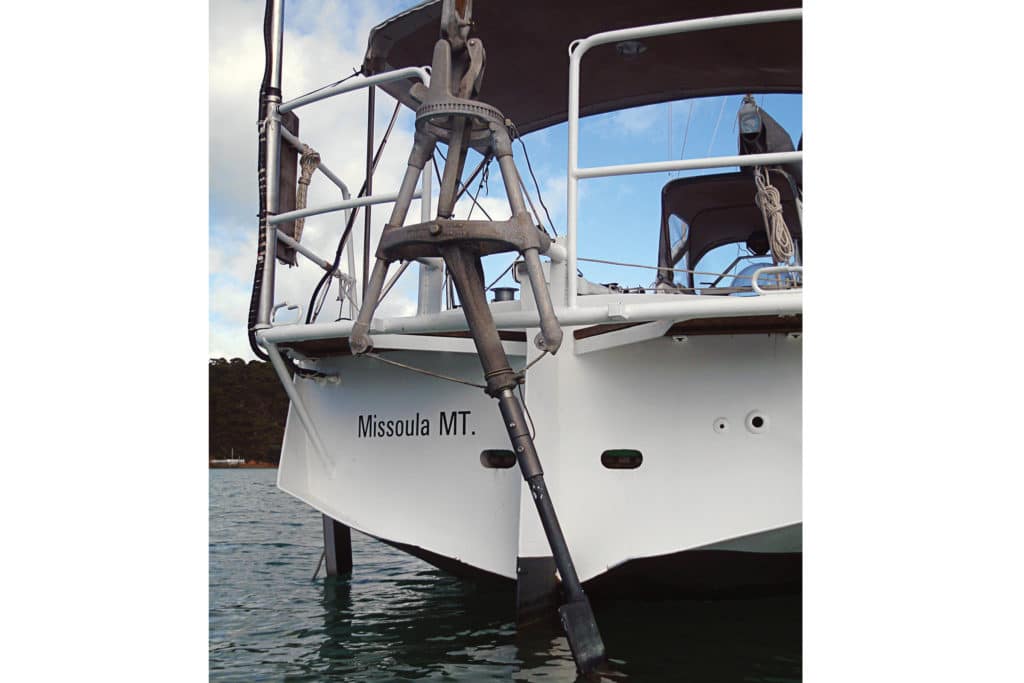
Types of Sailboat Windvanes
Introduced by the indomitable Blondie Hasler, founder of the OSTAR solo transatlantic race in 1960, the original sailboat windvane consisted of a direct coupling of a horizontally rotating (vertical axis) vane to a trim tab on the aft edge of a transom-hung rudder. Once the vane was fixed to the desired angle off the wind (using a round base plate with notches spaced at 5-degree intervals), any course change rotated the large vane like a weathercock. This in turn twisted the tab to one side of the main rudder, driving the rudder in the opposite direction, thus bringing the vessel back on course. The advantage to this system was its ease of construction and low cost, but it was best adapted to the waning style of transom-hung rudders. Also, a large vane was required to harness sufficient wind to power the trim tab. Therefore, especially in light airs, the tall, heavy vanes often reacted more to the yaw and roll of the vessel than to the wind, resulting in erratic meandering.
However, from this early and rudimentary concept, two sophisticated yet distinct types of vanes evolved: the servo-pendulum system (SPS) and the auxiliary rudder system (ARS). Both SPS and ARS systems employ a counterweighted horizontal- or vertical-axis wind vane to activate an appendage in the water, but the similarities end there. (To confuse the issue, there is now a hybrid system called the servo-driven auxiliary rudder, or SAR. But by first addressing the two basic concepts, a clearer understanding of this marriage of ideas will emerge.)
The SPS system — best represented by brands such as Aries , Cape Horn , Fleming, Monitor and Sailomat — uses the movement of the windvane to horizontally turn an independent servo-rudder (essentially a separate oar or paddle) that is deployed into the water. As the boat moves, the laminar flow of water presses against the positive lead on the servo-rudder, generating sufficient power to aggressively swing the servo-pendulum, or windvane, in one direction or the other.
While it is the power of the wind that directs the angle the servo-rudder presents to the passing water, it is boat speed through that water that exerts the considerable pounds of pull on the lines that run from the servo-rudder and through a series of turning blocks, ultimately connecting to the tiller (or, in the case of wheel steering, a drum in the center of the wheel). More simply, the servo-rudder does not turn the boat; it pulls on the tiller or rotates the wheel, which in turn moves the main rudder.
Perhaps the main drawback to this concept is the limited throw of the lines, as the distance of arc through which the pendulum swings is limited to the width of its supporting frame, an average of approximately 10 inches. This is no issue when connected to a tiller because one can fix the lines at the optimum point on the helm: high for more power, lower for a greater turning angle. But depending on the stop-to-stop ratio of a wheel steering system, the length of pull may not be sufficient to effectively control the vessel. This problem can be exacerbated by center-cockpit designs, as longer line lengths may stretch more, further limiting the effective length of pull.
The ARS system, best represented in the market by Hydrovane , employs an altogether separate appendage to steer the vessel. The boat’s main rudder is usually fixed amidship (or angled slightly to offset a lee or weather helm) and a second, auxiliary rudder, directed by a windvane, takes control of the steering. Thus, it is not only a self-steering device, but can also serve as an emergency rudder. Considering that all four of the Mayday calls I monitored on one of my Pacific crossings related to steering failure, this redundancy has considerable value. Because of the forces placed on this rudder it must be robust in construction, well fixed to the vessel, and of sufficient design and size to handily maneuver substantial tonnage.
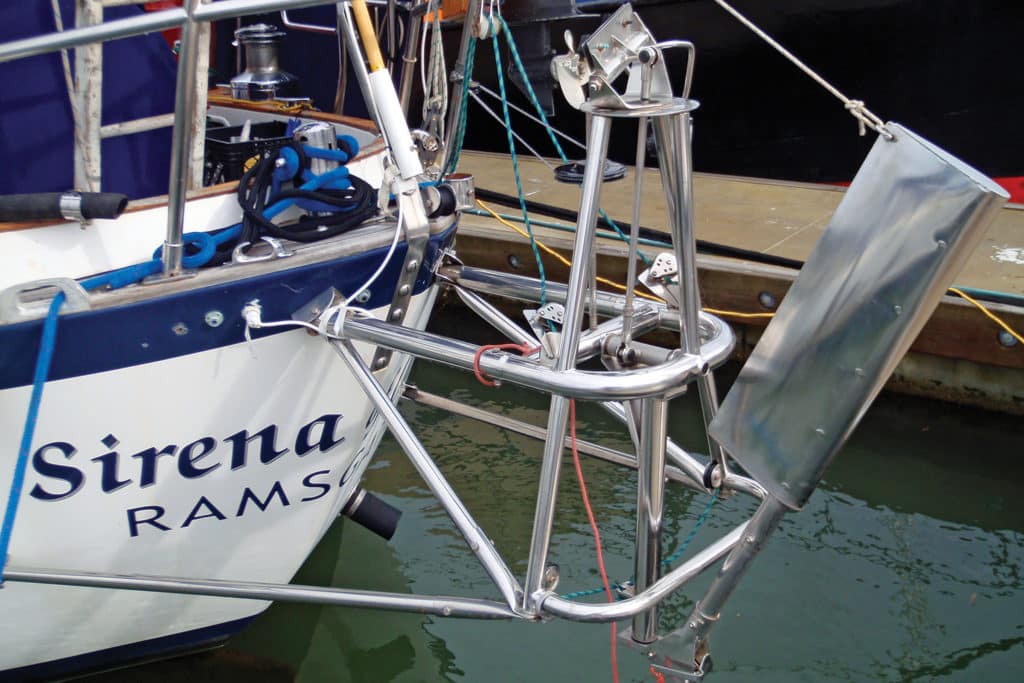
Pros and Cons of Sailboat Windvanes
There is a heated online debate among some of the manufacturers and distributors of the respective systems, each dismissing the supposed advantages of the other’s design concept while touting their own. I have sailed with both servo-pendulum designs and auxiliary rudders and found both to be practical and reliable; the final decision, to me, comes down to the type of vessel to which they will be attached, the steering system onboard, the conditions of sailing most likely to be experienced and the budget. In my opinion, the auxiliary rudder is more sensitive in light air, which is the average condition found in many recreational sailing areas. I’ve found the servo-pendulum model to be rock steady in conditions so rough that the average helmsperson would be exhausted within an hour.
But there are advantages and disadvantages to each approach. For example, the auxiliary rudder windvane has no provisions for being lifted out of the water to clear flotsam and seaweed; it can affect the backing characteristics of a vessel; and there’s no dedicated, engineered, breakaway “weak spot” when colliding with something like a submerged log. (In such instances, most servo-pendulum rudders simply flip up out of the way, and are popped back in place with the pull of a line.) On the other hand, auxiliary rudders don’t require lines that obstruct the decks and cockpit, a significant advantage depending on the placement of the helm.
To the latter point, perhaps too much is made of the difficulty in fixing, releasing and adjusting the tension of the lines on an SPS windvane. I corrected this problem with a $5 double jam cleat. Instead of using the typical link in a chain to connect to the tiller, I run my lines through an eye bolt on the tiller and back to the jam cleat. I can ease or tighten the lines balancing friction with precision; introduce infinite increments of bias to help balance the boat; and even when under tremendous pressure, immediately release the lines in an emergency situation.
A subtle but potentially important advantage of the SPS windvane is its natural aversion to broaching. As a steep wave slams into the quarter, the vessel can violently swing sideways. However, this same sudden sideways force pushes the servo-rudder in a direction that immediately tries to turn the boat back down the face of the wave. But even that point could be countered with the claim that by fixing the large main rudder in place, as in an ARS, substantial lateral stability is added to the vessel, thus minimizing any penchant to broach.
When mounting either system, the latest sailboat design trends — open, aft-entry cockpits and drop-down transoms — present new challenges. Hydrovane makes the unequivocal claim that its ARS windvane can be mounted off-center without affecting performance. Offsetting the vane opens access to the sugar scoop and/or the boarding and swim ladders. But as drop-down transoms, in particular, become ever beamier, there is less flat and fixed space available for robust windvane mounting. Depending on the stiffness of the vessel, one would not want to push the vane too far outboard for fear of lifting the auxiliary rudder clear out of the water on a heavy heel.
All SPS manufacturers stress the importance of meticulous centering during initial installation. Adapting to these new transoms, Monitor has introduced the SwingGate system to its windvanes. This is essentially a pivoting pushpit, much like a garden gate, with the vane attached. When the gate is open the boarding platform or swim ladder can be accessed, and when the gate is closed the vane sits firmly fixed amidship.
While completely appropriate for trimarans, windvane steering is not well suited for catamaran designs due to the dual rudders and high bridge-deck clearance.
As to pricing, there is no denying that the basic ARS units cost from 25 to 40 percent more than SPS models. Acting as the boat’s main rudder demands that the auxiliary rudder and mechanisms be constructed from heavy, high-quality materials. But if one chooses the swing-gate option, the additional cost of the gate structure must also be factored in.
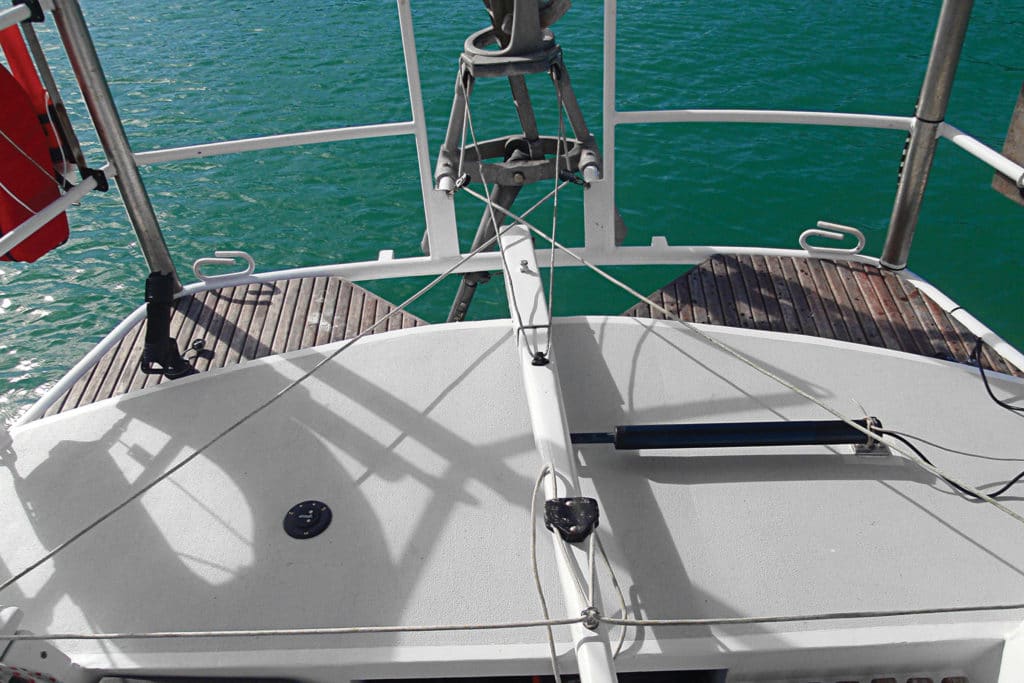
Summing Up Self-Steering
When choosing a self-steering system for your sailboat, closely assess the design features of your boat and the conditions you will most often encounter. If you intend to make any kind of extended passages, consider a high-quality mechanical self-steering unit, possibly coupled with a lighter electrical system. Often, the two can be combined, offering the precision of fluxgate steering with the power and toughness of mechanical systems (see “ A Hybrid Self-Steering Solution “).
After the initial expense of purchase and installation, there will be no piece of equipment on your vessel more prized than your mechanical self-steering. I don’t know of a single long-distance sailor who has given a name to the roller-furling system, nor of one who has not named the windvane. Be it SPS or ARS, called Esther or Otto, trust me, out there on the Big Blue you will have many long and meaningful conversations with it.
But like all relationships, this one requires practice and patience. First and foremost, do not ask the windvane to make up for sloppy sailing. Balance your boat, starting with waterline trim. Keep the weight out of the ends and ensure that the sails are appropriately sized, set and trimmed to the conditions. Excessive heel is not only slow, but places the boat on lines that the designer never intended, resulting in poor tracking. Ensure that the windvane is not blanketed by superstructure or fed turbulent air via barbecues, solar panels or davits. Experiment with different settings, such as blade angle and line tension, to understand and optimize performance in various conditions.
Models that employ a mix of metals should be disassembled, cleaned and lubricated regularly to minimize electrolysis. When reassembling, use a high-grade barrier cream on all fasteners.
All models benefit from an occasional bath of scalding-hot fresh water to dissolve any buildup of salt, minerals and solidified grease.
And finally, for those concerned that these protruding, industrial-looking structures may ruin the lines of an otherwise lovely vessel, remember: “The rougher it gets, the better they look.”
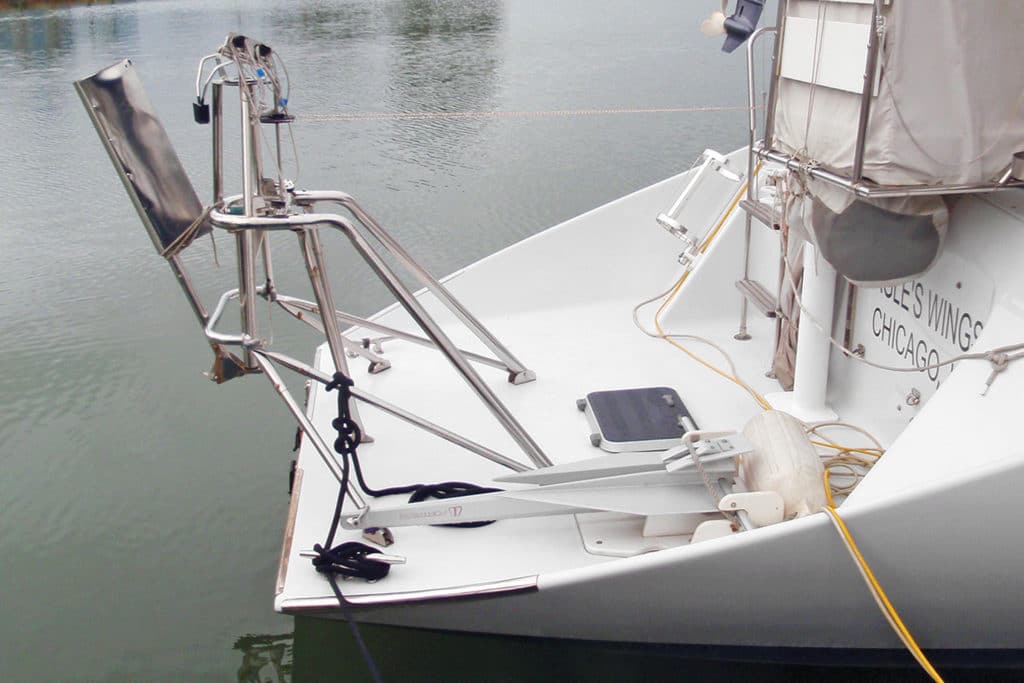
Windvane Manufacturers
Aries Vane Gear ariesvane.com and ariesvanegear.com Cape Horn Marine Products Fleming Marine Hydrovane International Sailomat USA Scanmar International Voyager Self Steering Inc. Windpilot
Two-time circumnavigator Alvah Simon is a CW contributing editor. This article first appeared in the July 2014 issue of Cruising World as “A Vane to Steer Her By.”
- More: How To , installations , windvane
- More How To

3 Clutch Sails For Peak Performance

It’s Time to Rethink Your Ditch Kit

8 Ways to Prevent Seasickness

How To De-Winterize Your Diesel Engine

Grenadines Boat Hijacking Suspects Charged with Murder
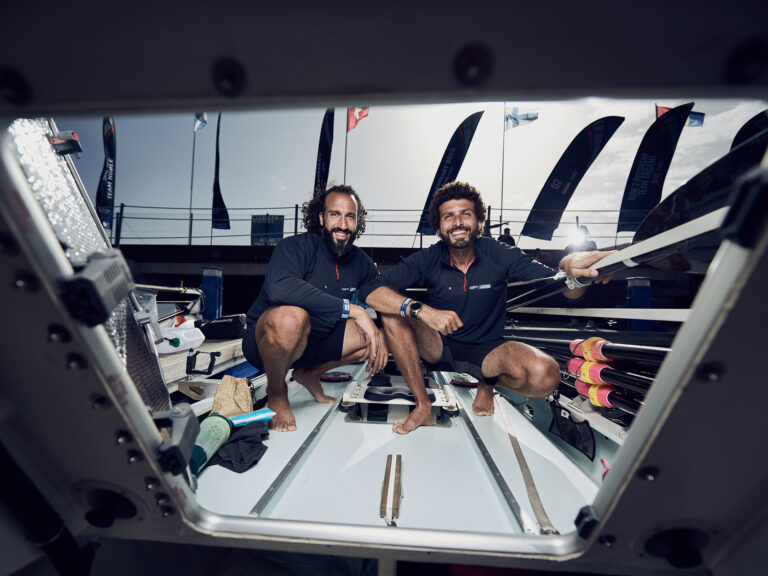
13 Hours in a Life Raft
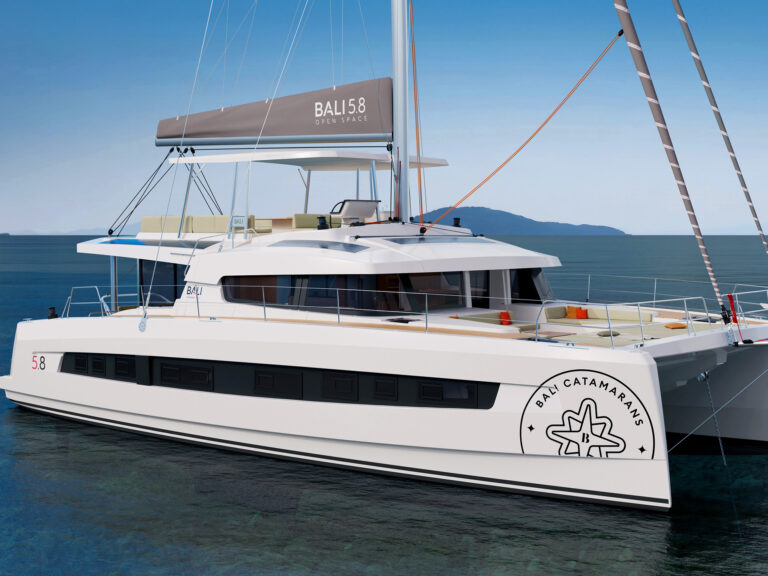
Meet the Bali 5.8
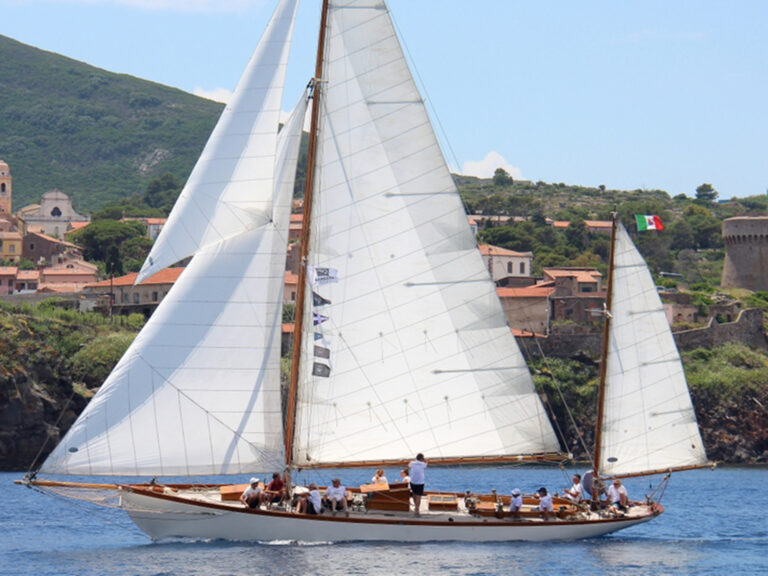
Celebrating a Classic
- Digital Edition
- Customer Service
- Privacy Policy
- Terms of Use
- Email Newsletters
- Cruising World
- Florida Travel + Life
- Sailing World
- Salt Water Sportsman
- Sport Fishing
- Wakeboarding
- MarketPlace
- Digital Archives
- Order A Copy

Steering by the Wind
Seasoned offshore sailors who have experienced freak waves, knockdowns and serious equipment failures generally agree there is one piece of equipment without which they could not imagine leaving port: a wind vane self-steering system. A scenario to consider: A retired couple with little or no offshore sailing experience sets off on an ocean crossing, and 800 miles offshore they are hit by a freak wave that swamps the vessel and wipes out all the electronics except for the handheld GPS and VHF radio. They finally clear the cabin of water, and they are still able to sail, but the autopilot no longer has a power source. Reluctantly, they resign themselves to alternating two-hour stints at the helm until they reach the next port 1,200 miles away. Another scenario is the autopilot simply breaking down a few thousand miles into a voyage, requiring parts and technical expertise rarely found outside the developed world. Imagine the time, expense and headache that could be saved by installing a well-designed, solidly built wind vane system. Wind vanes routinely survive knockdowns and even capsizes with nothing worse than a broken plywood air vane, easily replaced in less than two minutes underway. “But my boat has a center cockpit and hydraulic steering. I can’t possibly use a wind vane.” Actually, you will be happy to know there are several models designed specifically for situations where traditional servo-pendulums, such as the popular Monitor, Aries and Sailomat, would be difficult or impossible to use. “I like the idea of a wind vane, but I don’t want lines weaving across the cockpit.” The Cape Horn, manufactured by Yves Gélinas in Quebec, offers all the advantages of a servo-pendulum but operates below-decks directly on the steering quadrant, leaving the decks clear of steering lines. Other options include designs employing a separate auxiliary rudder, totally bypassing the main steering. So no matter what type of sail rig or transom configuration your boat has, if your boat’s LOA measures between 20 and 65 feet, there is a wind vane solution for your sailing vessel. Vessels with canoe sterns or boomkins may require a bit more imaginative engineering to design a mounting system, but most wind vane manufacturers have installation plans ready for virtually every production boat in the world’s voyaging fleet. Types of wind vane steerers Before settling on a particular type of wind vane, or “vane gear,” you first need to have a basic understanding of what types of systems are available on the market. The most common is the servo-pendulum. This machine uses a thin, flat, vertical piece of plywood or plastic to transmit changes in the apparent wind to a submerged servo-blade via a pair of bevel gears. The servo-blade responds by swinging sideways in the oncoming water and controlling the helm with a pair of steering lines. This is a proven, robust system, and not nearly as complicated as it may sound. I offer my own vessel and vane gear as an example of the wonders of the servo-pendulum. A Fleming Global 301 steered my 1966 Cal 30 Saltaire 30,000 nautical miles around the earth without a single repair, save a few broken air vanes during severe storms in the Tongan Triangle of the South Pacific and in the Red Sea. To this day, I still do not own an electronic autopilot, although a tiller pilot would be handy for motoring through calms. A hybrid version of the servo-pendulum incorporates an auxiliary rudder, enabling the unit to totally bypass the main steering system, which is locked while the vane gear is in operation. Peter Förthmann of Hamburg, Germany, incorporates this “double-rudder” system in the Windpilot Pacific Plus and Plus II. He also manufactures two sizes of standard servo-pendulum, the Windpilot Pacific and Pacific Light. The third type is the trim tab, best known these days as the Auto-Helm, not to be confused with Autohelm autopilots. The trim tab, similar to an airplane aileron, is hinged to the trailing edge of an auxiliary rudder so that the two operate together in lieu of the vessel’s main steering. The helmsman trims the system’s air vane parallel to the apparent wind in the same manner as with a servo-pendulum. The Auto-Helm trim tab and Monitor servo-pendulum are both manufactured by Scanmar in Point Richmond, Calif. Finally, the fourth type of system is what we may call the “air vane-controlled auxiliary rudder,” known as the Hydrovane and manufactured in Nottingham, England. This system converts wind impulses from a very large air vane directly into steering power through reduction gears. Tom Bridgman of the Pierre Garoff-designed, 40-foot, center-cockpit ketch Axe Calibre (Axmouth, England) told me that on one occasion when the boat was at anchor, he tried to turn the auxiliary rudder manually with the air vane set in about 10 knots of wind. With his arms bear-hugging the rudder and one foot pushing against the transom, he tried with all his might but could not budge the rudder; such was the force as amplified by the reduction linkage. Emergency rudder capability Another major advantage of vane gear steering mechanisms is their ability to double as emergency rudders. In the event your vessel incurs loss of, or damage to, the main rudder, a vane gear can provide the steering power you need to reach your next port. If your vessel is fitted with an Auto-Helm trim tab, Windpilot Pacific Plus or Hydrovane, no adaptations are needed to use the system in place of your vessel’s main steering while under sail. Simply lash the helm or steering quadrant, set the air vane for the desired heading, and let the auxiliary rudder steer the vessel. For motoring, each of these systems may be adapted easily for manual steering. Most of the standard servo-pendulums, including Fleming, Monitor and Sailomat, can be modified at sea with an optional kit to act as emergency rudders, but because they are not self-contained systems, they must be operated either manually or with the aid of an electronic tiller pilot. Monitor’s Monitor Emergency Rudder (MRUD) is a large, stainless steel rudder that the operator latches onto the servo-blade shaft after removing the servo-blade. Scanmar also offers a free-standing SOS Rudder, weighing only 35 pounds and capable of steering vessels of up to 50 feet in length. The SOS comes complete with mounting hardware and a tiller, which may be controlled with an electronic tiller pilot. Fleming offers a bolt-on rudder extension that connects to the servo-blade. Anyone using this system in rough weather will have to keep an eye on the various parts involved during assembly. Though I have never used this emergency rudder on my own Fleming vane gear, the system appears to be well designed and up to the task. Sailomat’s Blade Extension for Emergency Steering (BEST) is a wing-like foil doubling the area of the servo-blade. According to Dr. Stellan Knöös, who has designed all of Sailomat’s vane gear systems since the late 1960s, the BEST has been qualified as an emergency rudder in a number of ocean racing events where this valuable piece of safety equipment is required for entry. The underlying principle behind converting a servo-pendulum into an emergency rudder is fairly simple. First install the modified or substituted foil to the servo-blade shaft. Then stabilize the main shaft so that it does not swing laterally. Generally this involves nothing more than tying the steering lines to a pair of cleats. Finally, depending on the model, attach a handle, an extra pair of steering lines or a tiller pilot to the swiveling air vane base, and your emergency rudder is ready to steer. Getting the right fit Matching a wind vane steering system with your vessel takes some careful consideration. The main variables you must take into account are your boat’s main steering, cockpit location, transom profile and LOA. The easiest vessel to accommodate with vane gear steering is a 35-foot sloop with tiller steering, an aft cockpit and a flat or slightly raked transom. This conservative vessel design can accept every type of vane gear available on the market, including a Hydrovane, which would be a bit large for a 28-footer. A more difficult challenge would be a vessel of 50 feet with a canoe stern and hydraulic steering. Forget about a servo-pendulum in this case. Consider instead the Hydrovane or perhaps the Windpilot Pacific Plus II, each one very different from the other but equally useful where you must totally bypass the main steering in favor of a self-contained auxiliary rudder. Other options exist for situations where traditional servo-pendulums are impractical. The Cape Horn, because it may be configured to operate directly on the steering quadrant, is but one possibility for boats with center cockpits. Another option is the Auto-Helm trim tab, available in two different packages. The more popular option is the complete auxiliary rudder system. For those who want to save money on the auxiliary rudder and trim tab, there is the option of purchasing only the air vane servo-head and then building the two hydrofoils at home, incorporating – we would hope – appropriate NACA foil shapes for reduced drag and optimal steering response. In the case of a transom-mounted main rudder, a home-built trim tab connected to the main rudder’s trailing edge and controlled through cables by a remote Auto-Helm air vane head is the obvious choice where a trim tab is desired. If your vessel has an arch over the stern, install the Auto-Helm head in the middle of the arch between the solar panels or among your array of antennas, taking care to allow enough lateral swing room for the air vane. For owners of vessels with canoe sterns, boomkins or transom ladders who prefer the power of a traditional servo-pendulum, fear not: as long as you have an aft cockpit and either a tiller or a wheel with cable or bevel gear linkage, there is a way to couple your choice of vane gear to your vessel’s transom. Aries, Fleming and Monitor all use mounting tubes in their installation. Therefore, for mounting to a canoe stern, it is simply a matter of extending the tubes far enough to accommodate the elongated stern. The closer the lower mounting tubes come to the waterline, the more weight-bearing and torsion-resisting capacity they have. A boomkin may appear to be forbidden territory for a vane gear, but don’t be fooled. Adapters crafted from stainless steel plate and tubing can be custom-built to accept almost any vane gear design. You can expect to lay out a few extra bucks for an unusual installation, but wind vane manufacturers are highly competitive and innovative in their zeal to please clients with solid mounting designs. One of the most creative mounting concepts to come along in recent years is Scanmar’s SwingGate, which they have carefully engineered to couple a Monitor with a swim ladder over a sugar scoop transom. The Monitor becomes a gate that may be swung open while at anchor to enable use of the swim ladder. Sound impossible? My friend Tony Williams and his fiancée Mitsuyo left San Francisco on a Catalina 42 fitted with a SwingGate and crossed the Pacific to Australia with nary a hitch. The SwingGate is definitely what I call “having your cake and eating it too.” Making the decision Today the world of yachting is awash with new money and skippers with little or no offshore sailing experience. Many modern sailors feel comfortably secure extending a finger to poke a soft, rubberized button on an ergonomic keypad, delighting to a reassuring “beep.” It is understandably difficult for them to contemplate hand-steering in a full gale while crossing the Atlantic in January. Just imagine the diesel engine pooping out 500 miles into a 3,000-mile sail from Lanzarote in the Canaries to Martinique. The more we appreciate the raw reality of offshore voyaging, the more we prepare for things that should not go wrong, but do. If you are preparing for a major ocean passage on a sailing vessel single-handed or with short-handed crew, you will have a greater chance of success by depending as much as possible on mechanical, rather than electronic, systems. Foremost among your concerns should be your vessel’s self-steering. The wind vane self-steering systems covered in this article have all been in production for at least 30 years, some nearly 40 years, and all have performed well through multiple circumnavigations. When sailors and marina visitors see the vane gear on Saltaire’s transom, they know they are looking at a vessel that has “been places.” Vane gear on your vessel’s stern is a trophy distinguishing you as part of a small, elite corps of adventurers who dare to leave the familiar environs of coastal sailing and “go beyond.”
By Ocean Navigator
Wind Vane Self Steering: The Ultimate Guide
by Emma Sullivan | Jul 20, 2023 | Sailboat Gear and Equipment

Short answer: wind vane self steering
Wind vane self steering is a mechanical device used on sailboats to maintain a desired course without the need for continuous manual adjustment. It utilizes the force of the wind and a vertical axis to steer the boat by adjusting the position of the rudder.
How Wind Vane Self Steering Works: A Comprehensive Guide
Title: How Wind Vane Self-Steering Works: A Comprehensive Guide to Sailboat Autonomy
Introduction: Sailing is the epitome of freedom, embracing the unpredictable elements as we navigate vast oceans. However, when embarking on long journeys or overnight trips, the need for reliable self-steering systems arises. Enter wind vane self-steering! In this comprehensive guide, we will delve into this ingenious system, explaining its principles and mechanics while highlighting its benefits for seafaring enthusiasts. So hoist your sails and embark on a journey of knowledge as we unravel the inner workings of wind vane self-steering.
Chapter 1: The Basics of Wind Vane Self-Steering 1.1 Understanding Sailboats’ Balancing Act: – Explaining the importance of maintaining equilibrium between the sail and rudder configurations. – Highlighting challenges faced when manually helming during long passages.
1.2 Introduction to Wind Vanes: – Defining the wind vane as an autonomous steering mechanism driven by apparent wind direction. – Detailing their various components such as vanes, sensors, gears, and linkages.
Chapter 2: Principles Behind Wind Vanes 2.1 Apparent vs True Wind: – Unveiling the distinction between apparent and true wind direction. – Describing how wind vanes utilize apparent wind to adjust course.
2.2 Weight vs Force Systems: – Distinguishing weight-driven systems (servo pendulum) from force-driven ones (auxiliary rudder). – Discussing pros and cons of each system in different sailing conditions.
Chapter 3: Mechanics of Wind Vane Self-Steering 3.1 Servo Pendulum System: – Unveiling the engineering marvels behind servo pendulum systems. – Analyzing their interaction with changing winds and seas.
3.2 Auxiliary Rudder Systems: – Detailing the mechanism of auxiliary rudder systems, their hydrodynamics, and adjustability. – Discussing how they maintain sailboat course while minimizing yaw.
Chapter 4: Installation and Utilization Tips 4.1 Installing Wind Vanes on Different Sailboats: – Providing step-by-step instructions for mounting wind vanes. – Highlighting considerations for various boat designs and sizes.
4.2 Calibration and Fine-Tuning: – Elaborating on the importance of accurate calibration to ensure precise steering. – Offering pro tips to optimize performance under different sailing conditions.
Chapter 5: Advantages and Limitations 5.1 Benefits of Wind Vane Self-Steering: – Presenting the advantages of autonomy, reduced energy consumption, and enhanced safety during long-haul sailing trips.
5.2 Considerations in Complex Sailing Conditions: – Identifying limitations related to challenging weather patterns or narrow channels, necessitating manual intervention.
Conclusion – Navigating the Open Seas with Confidence: Wind vane self-steering systems revolutionize long-distance sailing by providing sailors with a reliable automated alternative to constant helming. Understanding the principles, mechanics, and installation tips outlined in this comprehensive guide will empower seafarers to navigate vast oceans with confidence, leaving them more time to revel in the beauty of their surroundings. Embrace the freedom that wind vane self-steering offers–the transformative companion for every true sailor!
Wind Vane Self Steering Explained: Step by Step Process
When it comes to sailing, one of the most essential tools for achieving steady and reliable course keeping is a wind vane self-steering system. This mechanism harnesses the power of the wind to effectively steer the vessel autonomously, ensuring sailors can enjoy a smoother and more hands-free sailing experience. In this blog post, we will delve into the step-by-step process of how wind vane self-steering works, unraveling its inner workings and highlighting its benefits.
Step 1: Understanding the Basics
Before we dive into the intricacies, let’s start with the fundamentals. A wind vane self-steering system consists of three main components: a wind vane, a linkage mechanism, and auxiliary steering gear. The wind vane acts as a sensory organ that detects changes in wind direction while transmitting these signals to the linkage mechanism. The linkage mechanism then translates those signals into appropriate movements, which are eventually transmitted to auxiliary steering gear responsible for adjusting sail trim or rudder angle.
Step 2: Wind Vane Sensitivity Adjustment
Once you’ve set up your wind vane self-steering system on board your yacht or sailboat, it’s crucial to fine-tune its sensitivity for optimal performance. By adjusting the weight distribution or adding counterweights to your wind vane, you can achieve precise responsiveness according to prevailing weather conditions. This careful calibration ensures that even subtle nuances in wind direction are accurately detected by the wind vane.
Step 3: Setting Course
Now that your system is finely tuned, it’s time to set your desired course manually using traditional methods such as compass bearings or GPS coordinates. Aligning your vessel towards this designated course provides initial guidance for your wind vane self-steerer.
Step 4: Autonomy Engaged
As soon as you activate your wind vane self-steering gear, you enable an autonomous sailor’s best friend. Once the wind vane starts detecting any deviations from your initial course, it sends signals to the linkage mechanism, instructing it to make corrections. This process ensures that your vessel automatically adjusts its heading to maintain the desired course against external factors such as wind shifts or gusts.
Step 5: Continuous Monitoring
While wind vane self-steering handles most course corrections independently, it does require regular monitoring to avoid any potential issues and make minor adjustments as needed. It is crucial to stay vigilant and keep an eye on how your self-steering system performs with changing wind conditions and other environmental factors.
Benefits of Wind Vane Self-Steering
Now that we’ve dived into the step-by-step process of wind vane self-steering, let’s explore its advantages:
1. Hands-free Sailing: With a properly calibrated and functioning wind vane self-steering system, sailors can free themselves from continuously holding the helm, affording a more relaxed sailing experience.
2. Increased Safety: Wind vane self-steering reduces fatigue in long ocean crossings by maintaining a steady course, minimizing human error risk at times when crew members might be physically exhausted.
3. Energy Efficiency: By utilizing the power of nature (the wind), a wind vane self-steerer requires no fuel consumption or electricity input for operation, making it an environmentally friendly and cost-effective solution for long-distance voyages.
In conclusion, the step-by-step process behind a wind vane self-steering system involves understanding the basics of its components, adjusting sensitivity levels, setting an initial course manually while enabling autonomy through continuous monitoring. This technology not only enhances safety but also allows sailors to enjoy hands-free sailing while embracing Mother Nature’s forces to keep their vessels on track efficiently. So why not embrace this clever innovation and sail away into effortless adventure?
Frequently Asked Questions about Wind Vane Self Steering
Frequently Asked Questions about Wind Vane Self Steering: Unlocking the Secrets to Effortless Sailing
If you’ve ever been on a sailing adventure or have spent any time around seasoned sailors, you’ve likely heard of wind vane self steering devices. These ingenious contraptions have sparked curiosity and interest among many sailing enthusiasts, but like any new concept, questions tend to arise. In this blog post, we will dive deep into the frequently asked questions surrounding wind vane self steering systems and shed light on their working principles. Get ready to unravel the science behind these mechanical marvels!
Q1: What exactly is a wind vane self-steering system?
A wind vane self-steering system is a mechanism designed to keep a sailing vessel on course without manual intervention from the helmsman. This device utilizes the power of the wind to maintain a steady heading even in challenging weather conditions. By harnessing wind pressure and utilizing specially shaped vanes, wind vane self-steering systems elegantly counterbalance forces acting on sails and rudders.
Q2: How does a wind vane self-steering system work?
The operation of a wind vane self-steering system revolves around one fundamental principle—using apparent wind angles and force to steer the boat. Typically mounted at the stern of a vessel, these systems consist of an arrow-shaped vane that reacts to changes in apparent wind direction. As the breeze shifts or fluctuates in intensity, subtle movements in the vane are transmitted via lines or linkage mechanisms to adjust the position of an auxiliary rudder at the boat’s stern.
When the boat begins deviating from its intended course due to shifting winds, turbulence, or waves, this auxiliary rudder automatically adjusts itself according to variations in apparent wind angles detected by the main vane. Consequently, as long as there is sufficient breeze available for propulsion, these systems effectively maintain precise navigation even during extended periods at sea. It’s like having an invisible helmsman tirelessly steering your vessel, allowing you to relax and enjoy the journey.
Q3: Are wind vane self-steering systems compatible with all types of boats?
Wind vane self-steering systems are highly versatile and can be installed on a wide range of sailboats. Whether you have a small, single-handed cruiser or a larger ocean-going yacht, there is likely a system that suits your vessel. The main considerations when choosing the right wind vane self-steering system for your boat include size, weight, balance, and how well it integrates with the existing rigging setup. Manufacturers provide detailed guidelines and support to ensure compatibility with various boat designs.
Q4: Can wind vane self-steering systems handle different weather conditions?
Absolutely! Wind vane self-steering systems are designed to thrive in diverse weather conditions and adapt to changing environments. Whether you’re facing calm seas or rough waters with strong winds, these remarkable devices remain stable and steadfast in their coursekeeping abilities. However, it is essential to learn about any limitations specific to the model you choose based on sailing experience and intended use.
Q5: Are wind vane self-steering systems difficult to install?
While installing a wind vane self-steering system may require some technical know-how, most reputable manufacturers provide comprehensive manuals and guidance materials tailored for DIY installations. However, if you prefer professional assistance or lack the confidence in setting it up yourself, seeking help from expert marine technicians is always an option worth considering.
In conclusion, wind vane self-steering systems offer sailors an unprecedented level of autonomy on their voyages by effortlessly maintaining course while they sit back and take in the panoramic beauty around them. Their ingenious working principles elegantly leverage wind power to navigate through uncharted waters. Embracing one of these marvels on your own sailing adventure might just be the key to unlocking new levels of sailing satisfaction. So, batten down the hatches, set your sails, and let the wind vane self-steering system be your faithful navigator on this extraordinary journey!
Mastering the Art of Wind Vane Self Steering: Tips and Techniques
For sailors navigating the vast blue oceans, wind vane self-steering systems are an invaluable tool. These impressive devices not only alleviate the stress of manual helm control but also empower sailors to sail solo or in small crews with ease. However, mastering the art of wind vane self-steering requires more than just installing the equipment – it demands practice, knowledge, and a cunning understanding of its intricacies. In this blog post, we will delve into the depths of wind vane self-steering, providing you with tips and techniques that will have you sailing like a seasoned pro.
Understanding the Basics:
To begin our journey towards mastering wind vane self-steering, let’s start by unraveling its fundamentals. A wind vane self-steering system essentially functions based on an aerodynamic principle: it utilizes changing winds to adjust your boat’s course automatically. The device consists of a wind vane mounted atop your vessel’s stern along with various lines and connections to your ship’s wheel or tiller.
1. Sail Trim is Key:
Properly adjusting your sails plays a crucial role in maximizing the efficiency of your wind vane self-steering system. Ideally, before engaging the device, ensure that your sails are appropriately trimmed for optimal performance based on existing weather conditions. Fine-tuning this aspect will allow for smoother operation and minimize any unnecessary strain on both boat and gear.
2. Get Acquainted with Your System:
Understanding how every component in your wind vane self-steering system works is vital for seamless operation. Familiarize yourself with all cables, lines, blocks, attaching points, and mechanical adjustments within your setup through careful study of instructions provided by manufacturers. Additionally, consider practicing installation and removal procedures before setting sail to save time during maintenance or repairs at sea.
3. Devise Efficient Linkages:
Connecting your wind vane to the ship’s wheel or tiller requires creating a linkage mechanism that transmits the vane’s signals accurately. Carefully select and adjust mechanical linkages, ensuring that they offer proper responsiveness and minimal play. Remember, any slack in these connections will decrease accuracy and compromise performance.
4. Experiment with Tension:
Fine-tuning the tension on your wind vane’s lines is essential for achieving optimal response. Experiment by adjusting the tension – both tightness and looseness – of these lines based on prevailing conditions such as wave heights, wind strength, course changes, or boat speeds. This flexibility allows you to adapt your wind vane self-steering system according to real-time situations and enhance its efficiency.
5. Observe Nature’s Cues:
Nature can be an exceptional teacher when it comes to utilizing wind vane self-steering systems effectively. Observing how wind shifts affect your vessel’s course during different weather patterns will help you develop a keen sense of understanding impending changes in wind direction. By balancing this observation with data from meteorological sources or barometers, you can anticipate shifts ahead of time, allowing for precise adjustments even before they happen.
6. Make Incremental Adjustments:
Once your wind vane self-steering system is activated, it is essential not to make abrupt adjustments unless absolutely necessary. Instead, opt for small incremental changes when altering course or sail trim. Gradual adaptations ensure smoother transitions without overwhelming the device with sudden demands.
7. Continuously Monitor Performance:
Constant vigilance is key while learning to master your wind vane self-steering system completely. Continuously monitor its performance by observing your boat’s behavior relative to sea conditions (weather helm, leeway). Appropriate awareness combined with timely tweaks ensures efficient operation throughout extended voyages.
8. Seek Expert Advice:
When seeking mastery over any subject matter, there is no substitute for expertise gained through experience and shared wisdom. Engage with sailing communities, forums, or seek advice from seasoned sailors who have honed their skills in wind vane self-steering. Their firsthand experiences and clever tricks will provide invaluable insights to propel your learning curve forward.
In conclusion, mastering the art of wind vane self-steering is a journey that requires practice, experimentation, and understanding. By grasping the basics, fine-tuning sail trim, learning your system inside-out, observing nature’s cues, and making incremental adjustments while monitoring performance attentively, you can unlock the true potential of this remarkable piece of sailing technology. So hoist your sails high and let the wind vane guide you towards a new realm of solo or small crew sailing prowess!
Choosing the Right Wind Vane Self Steering System for Your Boat
When it comes to sailing, there’s nothing quite like the feeling of gliding through the open waters, with the wind in your hair and the sun on your face. However, navigating a boat can be a challenging task, especially when you’re all alone out on the vast ocean. That’s where wind vane self steering systems come into play.
A wind vane self steering system is an invaluable piece of equipment that allows sailors to maintain course without having to constantly adjust their sails or helm. This automated system harnesses the power of the wind to steer the boat, freeing up valuable time and energy for sailors to focus on other important tasks.
But with so many different options available on the market, how do you choose the right wind vane self-steering system for your boat? Here are some key factors to consider:
1. Boat Size and Weight: The first thing you need to take into account is the size and weight of your boat. Wind vane self-steering systems come in various sizes designed to accommodate different vessels. It’s important to choose a system that is specifically built for boats within your size range to ensure optimal performance and stability.
2. Ease of Installation: As a sailor, you want a wind vane self-steering system that can be easily installed without requiring extensive modifications or additional support structures. Look for systems that come with clear installation instructions and minimal hardware requirements.
3. Weather Conditions: Sailors know that weather conditions can change rapidly at sea. Therefore, it’s essential to select a wind vane self-steering system that can handle a wide range of weather conditions – from light breezes to heavy winds and high seas. Look for systems that are durable and capable of maintaining control even in challenging weather scenarios.
4. Sensitivity Adjustment: Every boat handles differently based on its design and load distribution. To ensure precise control, choose a wind vane self-steering system that allows you to adjust its sensitivity to match your boat’s characteristics. This flexibility will enable you to fine-tune the system for optimal performance and responsiveness.
5. Reliability and Durability: When you’re out on the open water, you rely heavily on your equipment. Therefore, selecting a wind vane self-steering system from reputable manufacturers known for their reliability and durability is crucial. Look for systems made from high-quality materials that can withstand the harsh marine environment for years to come.
6. Cost: While cost should never be the sole determining factor, it’s still an important consideration when choosing a wind vane self-steering system for your boat. Evaluate different options and compare their features, performance, and price tags to find the best value for your money.
Now, armed with these essential considerations, you can embark on finding the perfect wind vane self-steering system that suits your boat and sailing needs. Remember to carefully research different products and consult with fellow sailors or experts if needed. With the right wind vane self-steering system onboard your boat, you’ll experience smoother sailing adventures like never before!
Troubleshooting Common Issues with Wind Vane Self Steering
Introduction:
Wind vane self-steering systems are a remarkable solution for sailors aiming to harness the power of the wind to navigate their vessels. By allowing the wind to guide the boat’s rudder, these systems reduce manual effort and provide a more reliable means of steering. However, like any piece of equipment, wind vane self-steering systems can sometimes encounter common issues that require troubleshooting. In this blog post, we will delve into some possible problems and provide professional, witty, and clever explanations on how to overcome them.
1. Lack of responsiveness: One frustrating issue that sailors may encounter with wind vane self-steering is a lack of responsiveness. If your system seems sluggish or fails to react promptly to changes in the wind direction, there are a few potential causes.
Explanation: Just like us humans after an indulgent Thanksgiving dinner, wind vanes can become lethargic too! The most common culprit for unresponsiveness is excessive friction within the system caused by wear or improper lubrication. To tackle this issue, start by giving your system a good inspection. Look for any signs of wear on bearings and joints while applying lubrication generously where needed (Think spa day for your wind vane). If this fails to resolve the problem, it might be worth checking if any foreign objects or debris have made their way into critical components – just imagine trying to navigate gingerly during peak pollen season!
2. Oscillations and instability: Unwanted oscillations or instability in your self-steering system can make sailing feel like riding a bucking bronco! This issue can be concerning and potentially dangerous if left unresolved.
Explanation: Imagine you are attempting to steer straight but your trusty wind vane has gained an affinity for dancing instead – quite embarrassing! The primary reason behind oscillations and instability is often an imbalance between sensitivity settings and sail trim (imagine mismatched dance partners). Adjusting both variables can help find the sweet spot. Additionally, thicker or heavier sails may contribute to excessive oscillations, so it might be time to reassess your sail wardrobe and consider adopting a lighter ensemble for smoother sailing (we all deserve a wardrobe makeover now and then!).
3. Misalignment and wandering: Has your wind vane suddenly decided to become an explorer, sailing in any direction other than the one you intended? Misalignment and wandering can occur due to various factors.
Explanation: Picture this – you want your wind vane pointing north, but instead, it decides it wants to discover hidden treasures in the opposite direction – quite the rebellious spirit! Misalignment is commonly caused by incorrect installation or loose connections between the wind vane and the boat’s rudder. Ensure that all parts are securely fastened with the precision of a complicated jigsaw puzzle (but without the frustration). When resolving misalignment issues, imagine you are showing your wind vane some tough love – tighten those nuts and bolts until they can’t even think about misbehaving!
Conclusion: While wind vane self-steering systems generally offer efficient steering solutions for sailors, encountering common issues is not uncommon. By understanding these challenges and implementing our witty troubleshooting advice, your wind vane will be back in shape in no time. Remember, a witty approach combined with professional expertise ensures smooth sailing both on water and through blog posts!
Recent Posts
- Approaching a Mooring Buoy: Essential Tips for Safe Navigation
- Best Tiller Autopilot: Enhance Your Sailing Experience
- Nautical Navigator: Essential Tools and Techniques for Seamanship
- Sail Making Material: A Comprehensive Guide
- 2 Person Dinghy: The Ultimate Guide to Choosing the Perfect Boat
- Sailboat Gear and Equipment
- Sailboat Lifestyle
- Sailboat Maintenance
- Sailboat Racing
- Sailboat Tips and Tricks
- Sailboat Types
- Sailing Adventures
- Sailing Destinations
- Sailing Safety
- Sailing Techniques
Windy Selfsteering
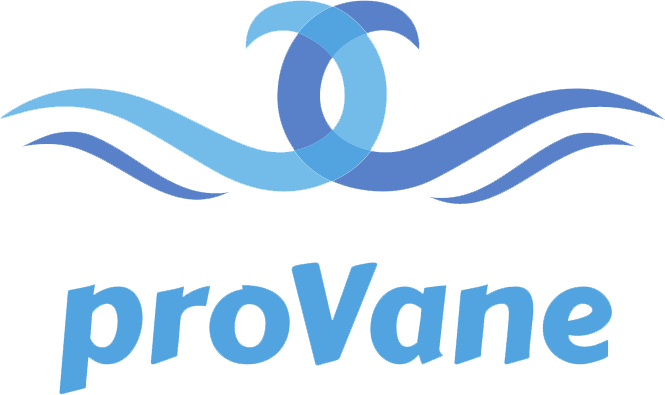
Tough, strong and reliable self steering

New Windy coming soon
Model Windy (servo-pendulum, currently not available) feedback and nice blog:
Sailblog Yacht Flirtie, Voyager 40 Blog1: https://www.sailblogs.com/member/distantdrummer/483079 Blog2: https://www.sailblogs.com/member/distantdrummer/483286 Blog3: https://www.sailblogs.com/member/distantdrummer/
About ProVane
ProVane is designed for a larger boat with wheel (also suits for tiller) and it has emergency rudder ability. ProVane can be mounted off-center.
It’s rudder is 300x1100mm and also the windvane is large, 520x1000mm. ProVane is stand alone system, auxiliary rudder type, no steering lines in cocpit for the wheel.
Advantages over electric autopilots:
- It does not require electricity for its operation.
- Robust and simple construction.
- Emergency rudder with tiller.
- Vessels rudder system does not wear on longer trips.
Dimensions PDF:
proVane dimensions
For better understanding user manual is downloadable by this link here (Google Drive):
Photos and videos
Take a closer look at our product

Make your sailing experience more enjoyable
Nb no new orders will take new orders in august. apologies.
Text goes here
Text goes here also
Selfsteering equipment idea was born while I was sailing around the world across three oceans on a 31-feet yacht.
On the last leg from South Africa to Cabo Verde, flight home being less than 4000 nm away, the old noname self steering gear broke down when a bigger breaker hit the yacht from the side.
This gave me a reason to start developing a new self steering system that would be stronger. The idea was to build the cheapest windvane on the market that would still keep its strength and quality. By now Windy windvane has successfully sailed across the Atlantic ocean many times.
S/Y Bellatrix
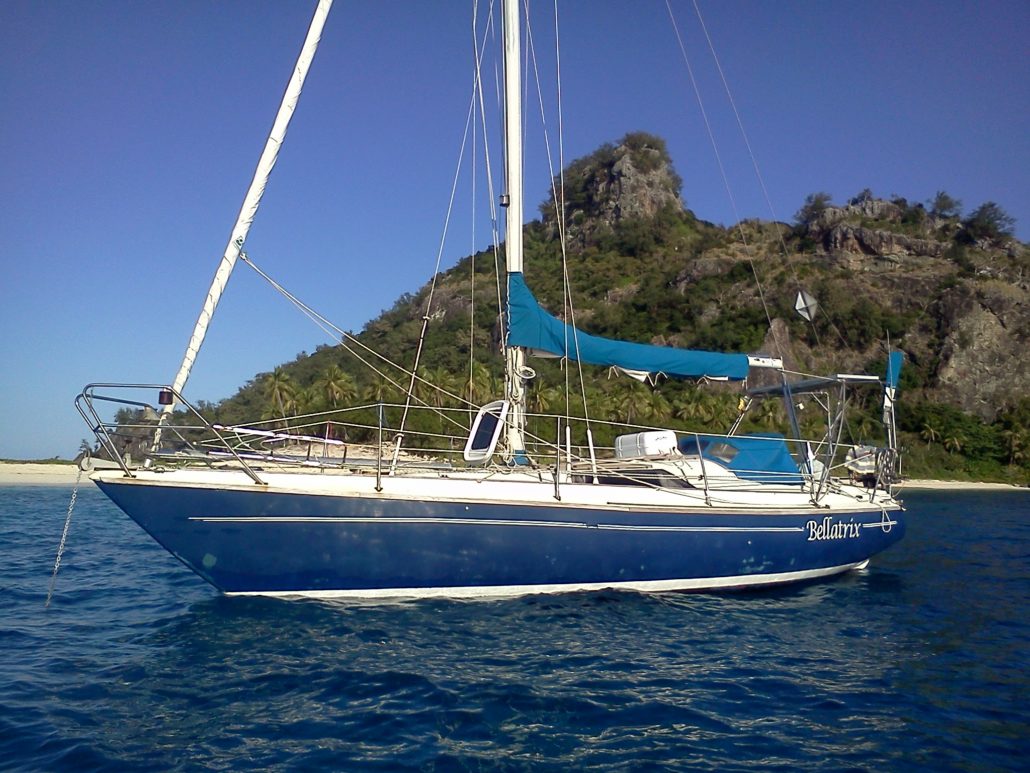
Got a question?
Silber Metallic OÜ
Registry code: 11574431
Address: Köömne 18, Tallinn, Estonia 10617
E-mail: [email protected]
Phone and WhatsApp: +372 5667 6656
Send us a message

- Construction
- Customer Reviews
- Pictures & Videos
- How it Works
- Rudder Links
- Servo Power
Neptune Servo Pendulum Windvane
Effective | reliable | safe | hassle free.

Yt. Shangri-La rounding Cape Horn

Trade Winds

Why a Neptune Servo Pendulum Windvane?
The Neptune Windvane works on a horizontal axis servo pendulum system. A servo pendulum windvane uses its own rudder, together with the yacht steering system, to keep the boat on course. A servo pendulum windvane is the most efficient form of yacht windvane self-steering available.
Neptune works well when motoring as long as the wind across the decks is above 5 knots. This is a big + and only possible as the mechanism has almost zero friction . The Neptune windvane is simple to operate!
It connects to the yacht’s existing wheel or tiller steering system and, once set, keeps the yacht on course. Any change in wind direction, or deviation from course, causes a movement of the Neptune’s windvane. These movements are transmitted both to the Neptune’s own rudder and to the yacht’s steering system, bringing the yacht effortlessly back on course.

We lovingly hand-build each Neptune servo pendulum windvane from the highest quality materials to ensure you enjoy many years of reliable self steering.
The Neptune build quality, together with the simplicity of a servo pendulum windvane, make it the ideal choice for a safe yacht passage. Read more about the construction of a Neptune servo pendulum windvane

We offer four models of the Neptune servo pendulum windvane to cater for yachts from 23ft (7m) to 50ft (15m). Read more about the Neptune servo pendulum windvane range

Naturally we believe that our Neptune servo pendulum windvane is just the best on the market.
Don’t just take our word for it, hear what our happy customers have to say.

IMAGES
VIDEO
COMMENTS
Golden Globe Update Day 113: [GGR Leader Jean-Luc Van Den Heede sailing the Rustler 36 Matmut] was full of praise for his Hydrovane self-steering. "In a gale it has a big advantage because it is not steering the boat's rudder, but has its own. This little rudder is far more efficient than the big rudder.". - Jean Luc Van Den Heede on ...
For the short-handed sailor planning long ocean crossings, a self-steering windvane is not essential but darn close to it. For boats with stern-hung rudders, a self-steering windvane can be constructed with readily available materials and a modest level of skill. It's all about leverage. There will be an air paddle which will weathercock to the…
The Digital plans are now ready to download!!!!! Proven on 2 Atlantic crossings, and 7800 nautical miles on open ocean. Ladies and Gentlemen, start building ...
Self-steering relies on a well balanced boat. As the wind shifts, the mechanism corrects. Self-steering gear works by adjusting the yacht's course in relation to the apparent wind. The first step to making this work as efficiently as possible is to balance the boat and reduce the amount of input required.
Item Details: Detailed drawings of how to build a low-cost wind self-steering system for your Wharram catamaran, mainly out of wood. Gives different set-ups for Classic, Pahi and Tiki designs. Based on the system that sailed Pahi 63 'Spirit of Gaia' round the world.
The Hydrovane Self-Steering Windvane is both a mechanical self-steering windvane for offshore sailboats and an emergency rudder. With our Hydrovane® wind-control systems, we offer a combination of wind-vane control and an always-ready emergency rudder, suitable for every stern. Off-centre assembly, even for modern yachts with bathing platforms ...
Windvane self-steering options fall into two categories, servo pendulum and auxiliary rudder. Servo pendulum solutions utilize your boat's own rudder and as the name suggests, auxiliary rudder products work with a separate, independent rudder system. We believe servo-pendulum systems like the Monitor are usually your best option. They are ...
The sensor vane is the brains of the self-steering system, but it needs apparent wind to work. Downwind sailing in light air—when apparent wind may be only a whisper—is one of the biggest challenges for a windvane steering system. Sensor vanes are of two types: horizontal axis or vertical axis.
For those who are looking to embark on longer passages, windvane self-steering is a good consideration. Join Hydrovane's Sarah & Will Curry as they talk you ...
This video explains, in simple terms, how wind vane self-steering systems work on yachts and sailboats. The video follows an easy flow from auxiliary rudder ...
It can take a bit of effort to strike up a working relationship with a self-steering wind vane but, as this skipper found, it can be well worth it ... Catamaran sailing; Bluewater sailing techniques;
A multihull is unaffected by heel but accelerates quickly; the apparent wind angle swings forward markedly. This explains why catamaran sailors have always relied almost exclusively on autopilots. However a windvane system can be useful on extended voyages. Servo-pendulum systems can produce perfect steering on catamarans.
The Hebridean wind vane is an innovative version of the tried and tested servo-pendulum self steering system for sailing boats steered by tiller or wheel. The Hebridean has crossed Atlantic and Pacific oceans but is also quick and easy to mount for weekend coastal sailing or jaunts across the Channel, Minch or other strait/sea. Stern freeboard.
The first time I used a vane self-steering gear in anger was back in the early 1980s, aboard my newly purchased UFO 34 cruiser-racer whilst delivering her home from Scotland through the Irish Sea. Fitted with a then state-of-the-art Aries vane, we had strong tailwinds for much of the way, which the vane handled fairly well, impressive because ...
Auxiliary rudders have an important feature that should be considered by anyone planning to purchase wind vane self-steering gear particularly for accident-prone spade rudder boats; an auxiliary rudder can effectively steer the boat in the event of a main rudder failure. This means that when the boat is sailing under control of the auxiliary ...
A traditional self-steering method is the transom-mounted wind vane. These systems consist of a wind sensitive vane and a steering device. As the vane senses changes in the wind it activates the steering system to return the boat to the selected point of sail. The steering system is very typically the rudder of the boat itself.
Sailing With a Windvane. When it comes to simple, robust, reliable self-steering — especially in snarly weather — a mechanical windvane is hard to beat. Manufactured in Sweden since 1976, Sailomat windvanes employ the servo-pendulum system (SPS) and are available in models to fit yachts from 26 to 55 feet LOA. Courtesy of Sailomat.
The wind vane self-steering systems covered in this article have all been in production for at least 30 years, some nearly 40 years, and all have performed well through multiple circumnavigations. When sailors and marina visitors see the vane gear on Saltaire's transom, they know they are looking at a vessel that has "been places." Vane ...
A wind vane self steering system is an invaluable piece of equipment that allows sailors to maintain course without having to constantly adjust their sails or helm. This automated system harnesses the power of the wind to steer the boat, freeing up valuable time and energy for sailors to focus on other important tasks.
Registry code: 11574431. Address: Köömne 18, Tallinn, Estonia 10617. E-mail: [email protected]. Phone and WhatsApp: +372 5667 6656. If you are a human seeing this field, please leave it empty. Windy's self steering gear will make your sailing experience more enjoyable. Windy is a strong, efficient, and reliable shipmate.
Re: Wind vane steering on catamaran? Lots of examples. So long as your cat isn't particularly prone to accelerating through puffs or readily surfs the vane should be fine. The abrupt changes in speed make a vane less desirable on faster boats where the apparent wind will shift a lot.
Join Date: Sep 2008. Location: Hervey Bay, Queensland. Boat: Spirited 380 Catamaran. Posts: 91. From what I have heard over the years, windvanes do not work well on cats as they rely on a steady apparent wind and a multihull reacts very quickly to wind changes and hence the variability of the apparent wind.
A servo pendulum windvane uses its own rudder, together with the yacht steering system, to keep the boat on course. A servo pendulum windvane is the most efficient form of yacht windvane self-steering available. Neptune works well when motoring as long as the wind across the decks is above 5 knots. This is a big + and only possible as the ...
WIND VANE self-steering - how we use ours. February 26. Hi folks, hope you are all well... We are back, and life is good. As mentioned in our last post, we will be concentrating on releasing more... Join to unlock. 1. Locked. By becoming a member, you'll instantly unlock access to 68 exclusive posts. 8.